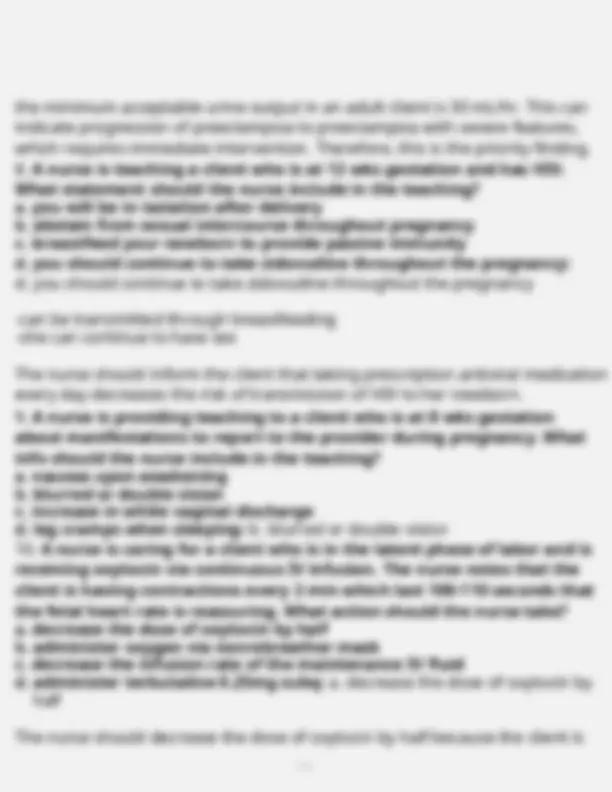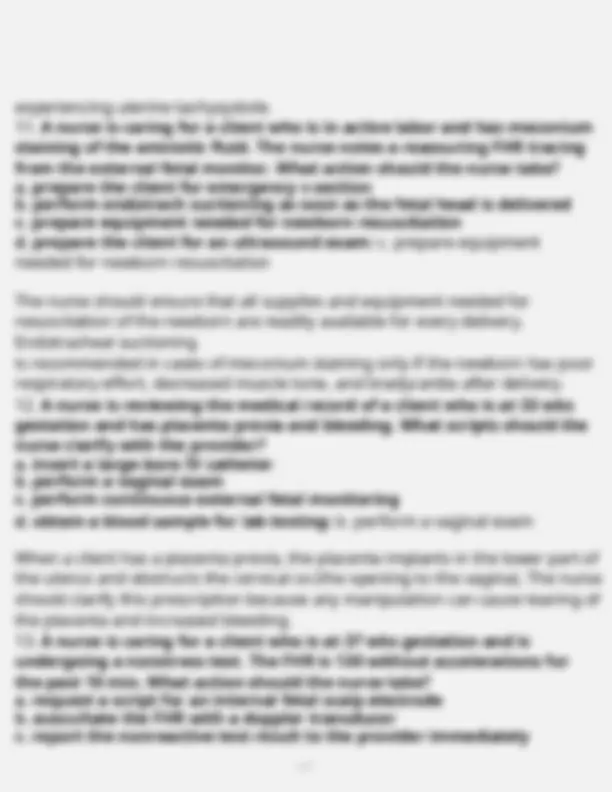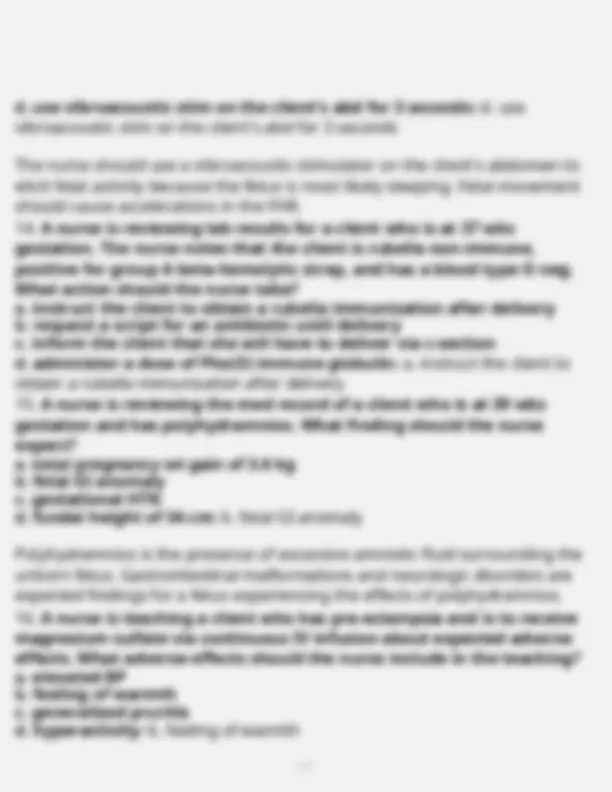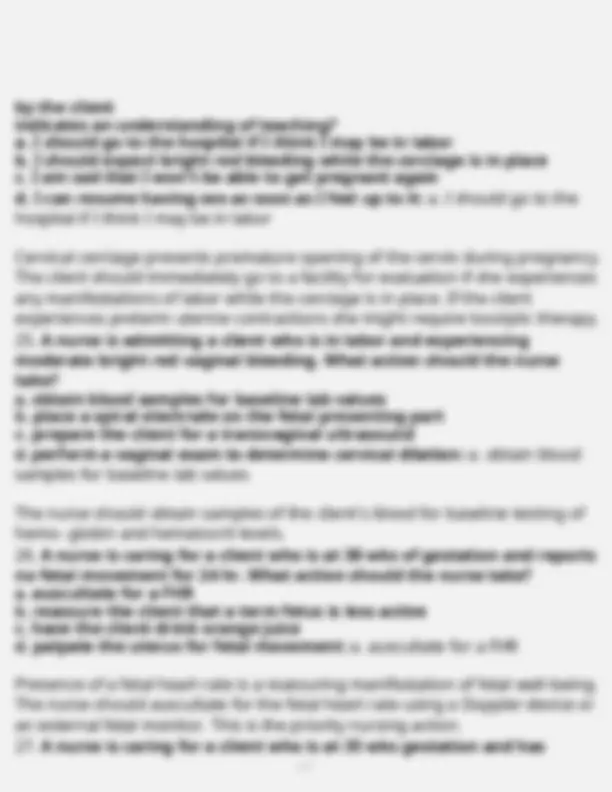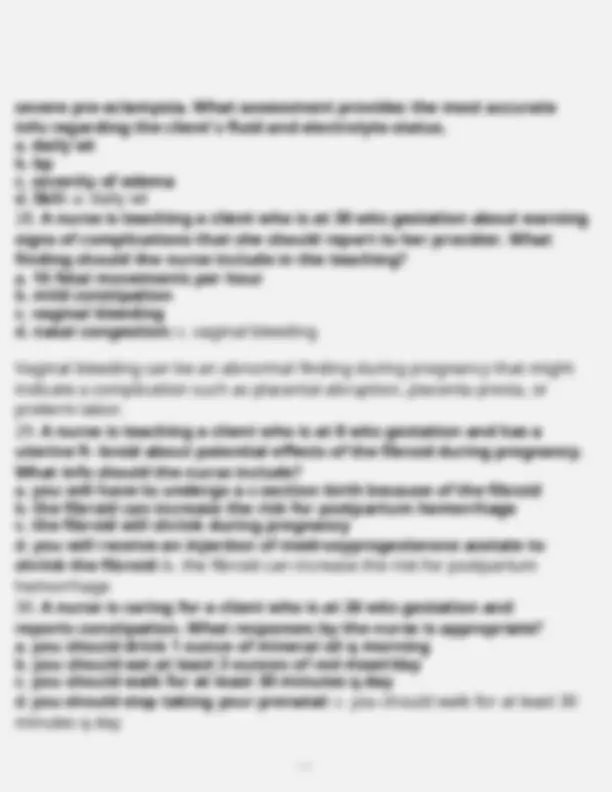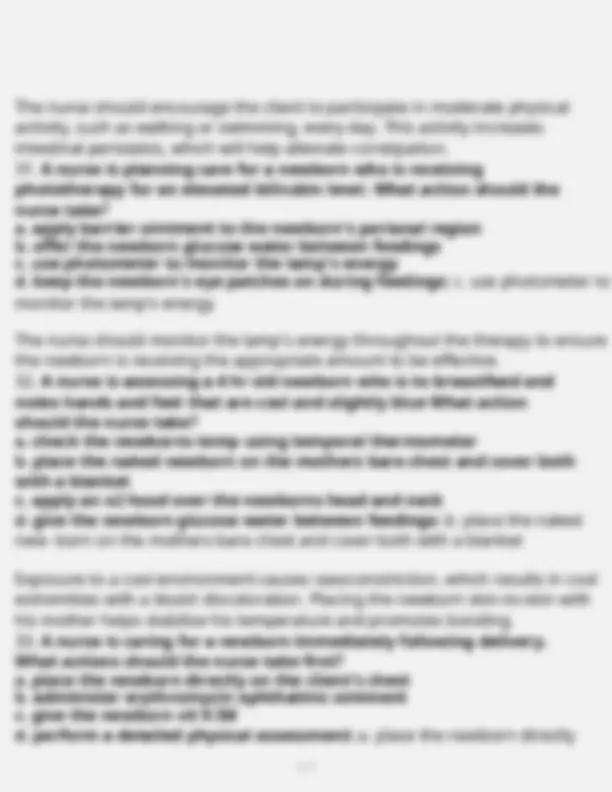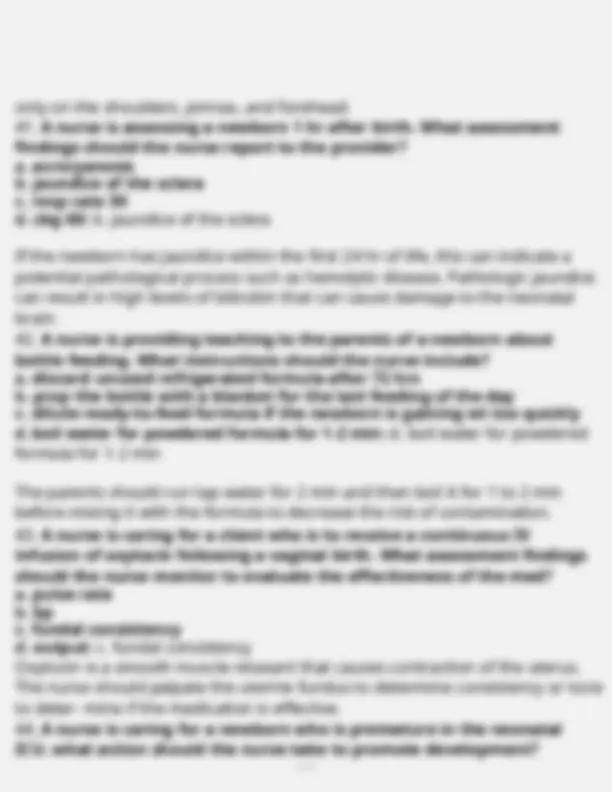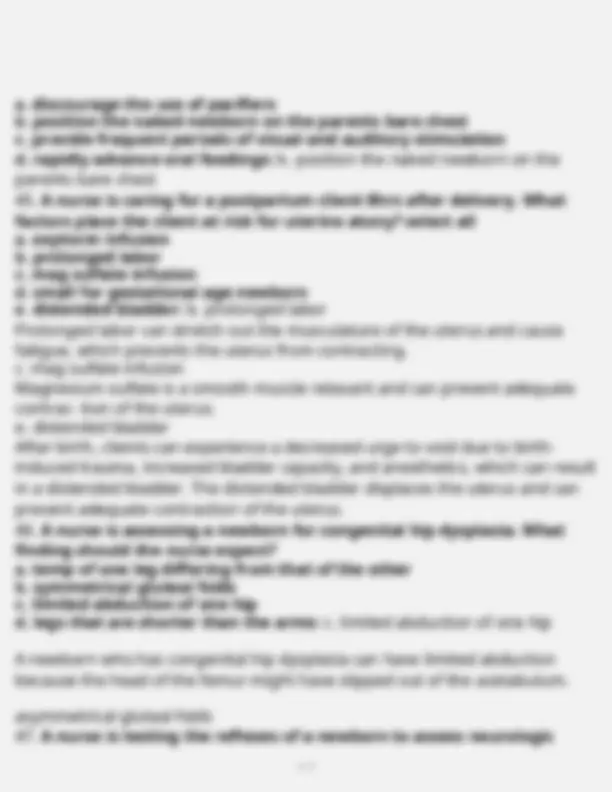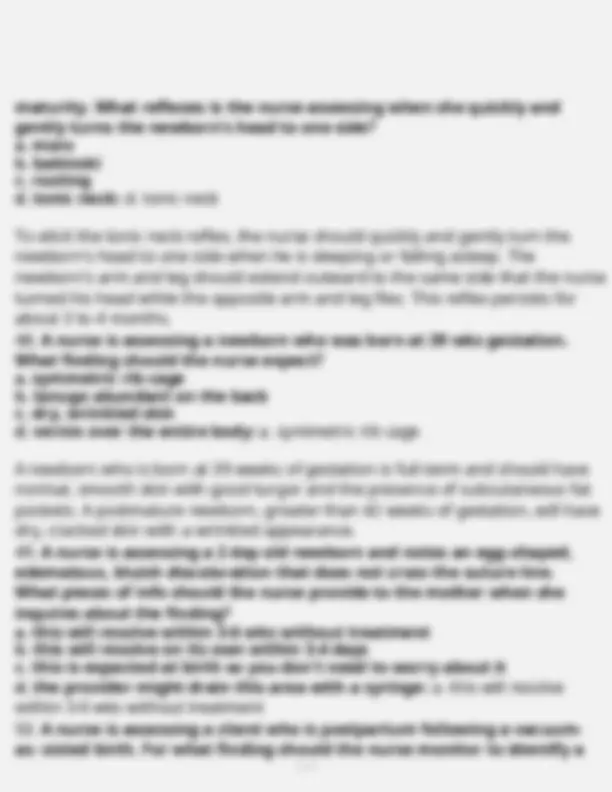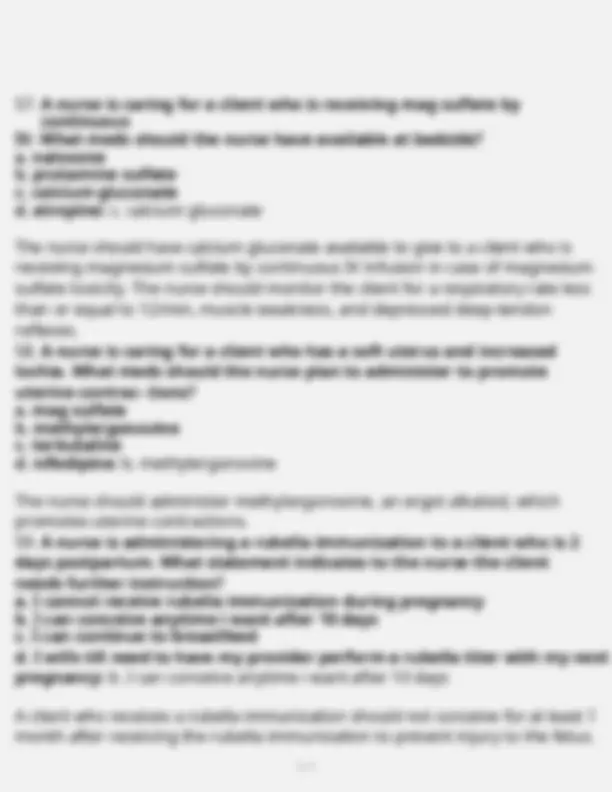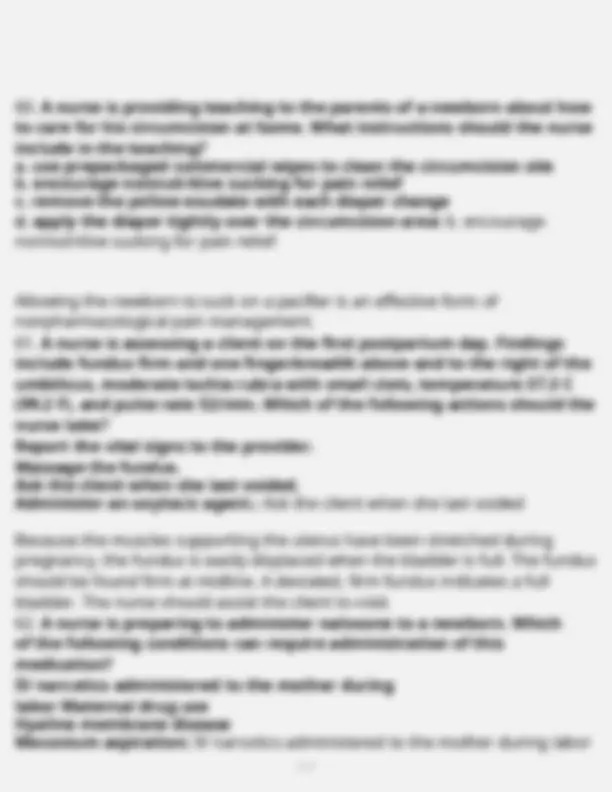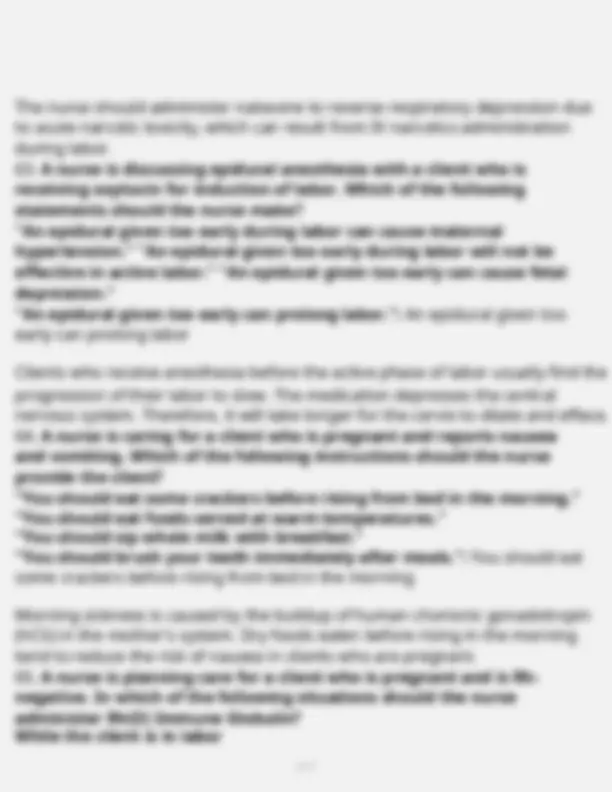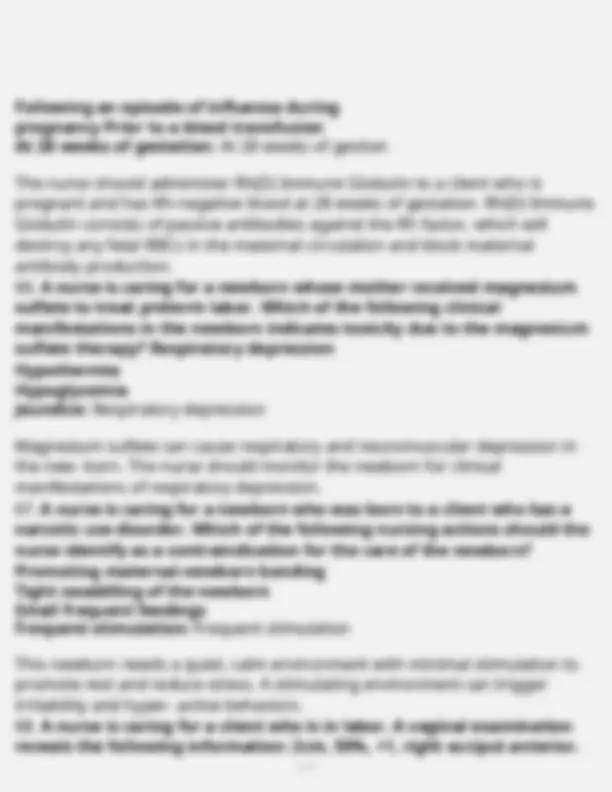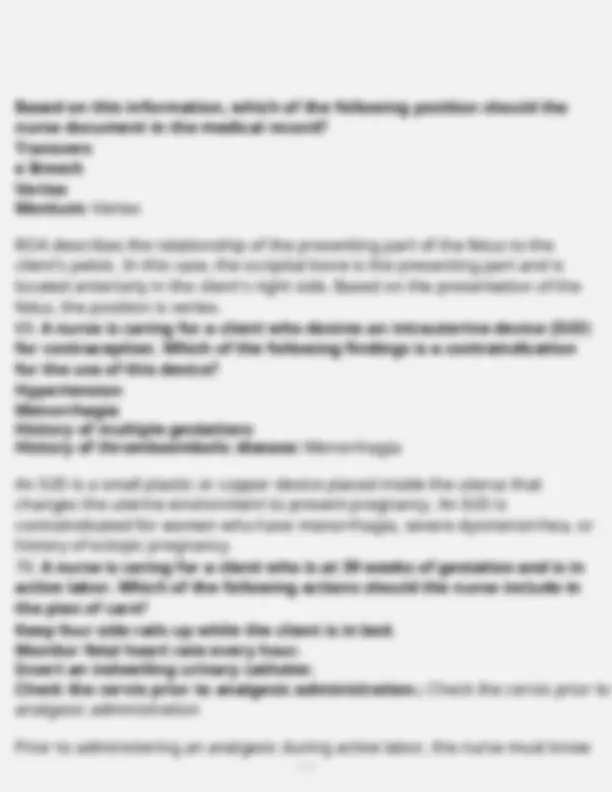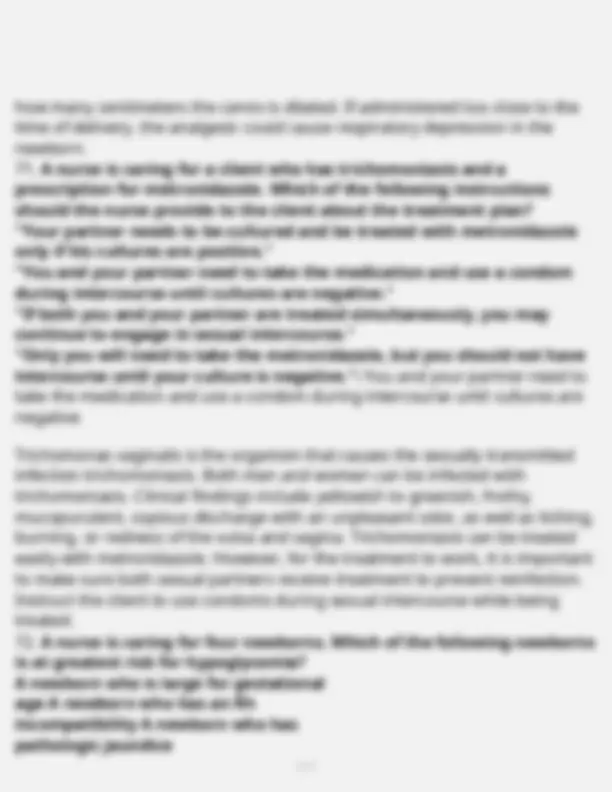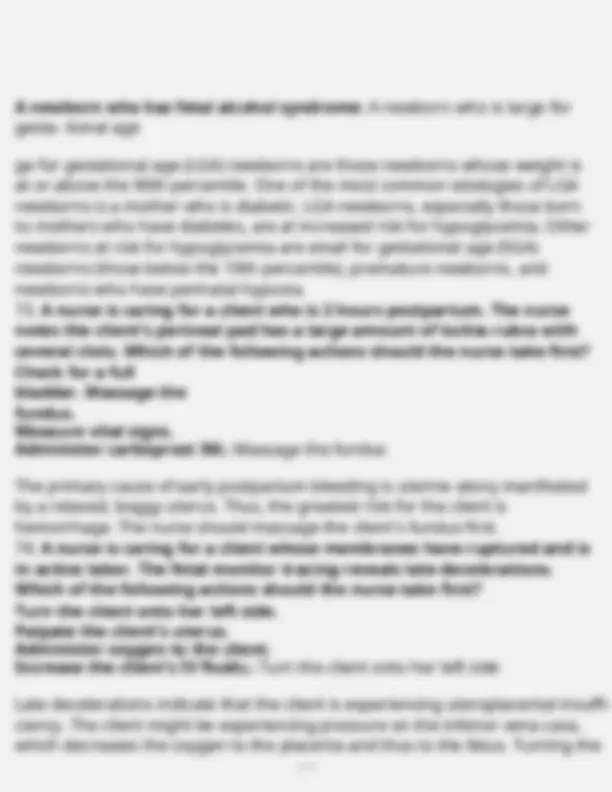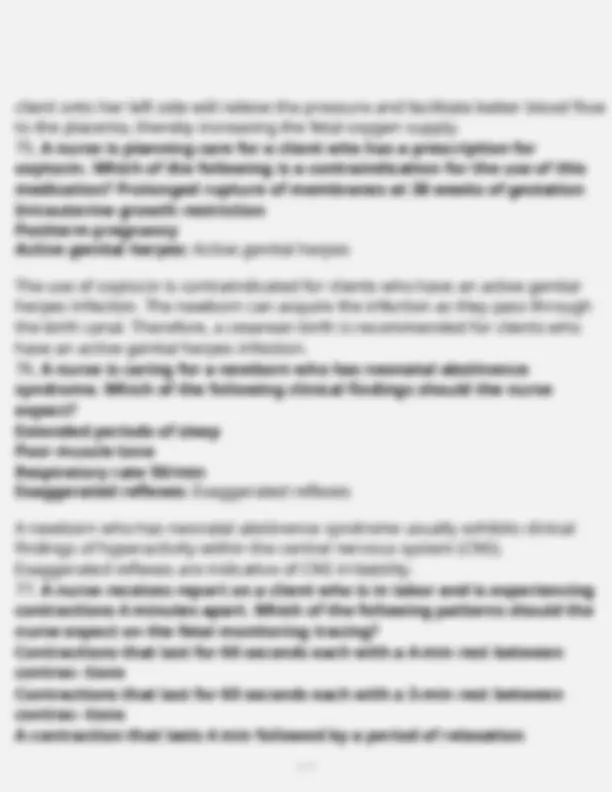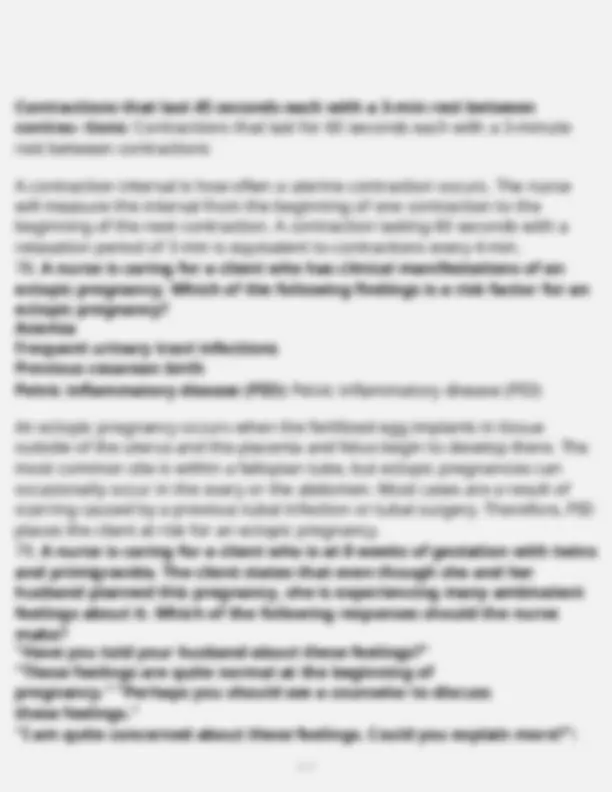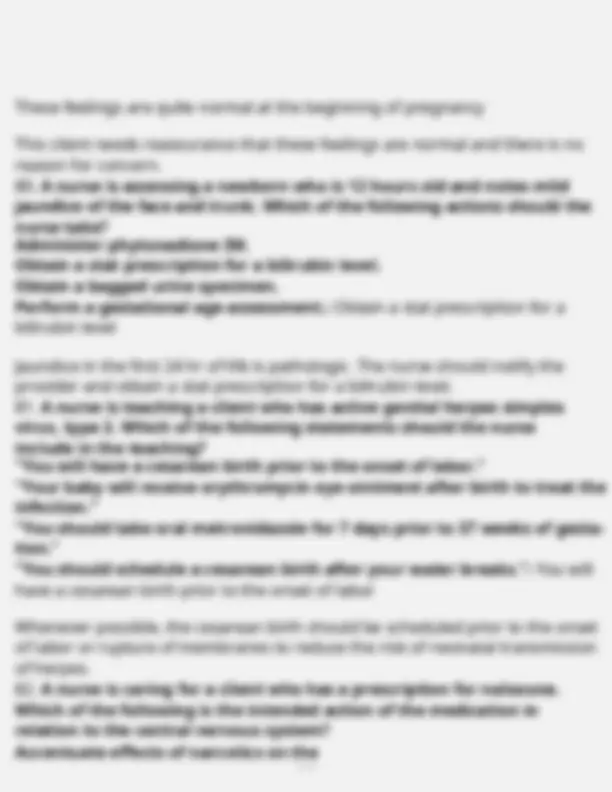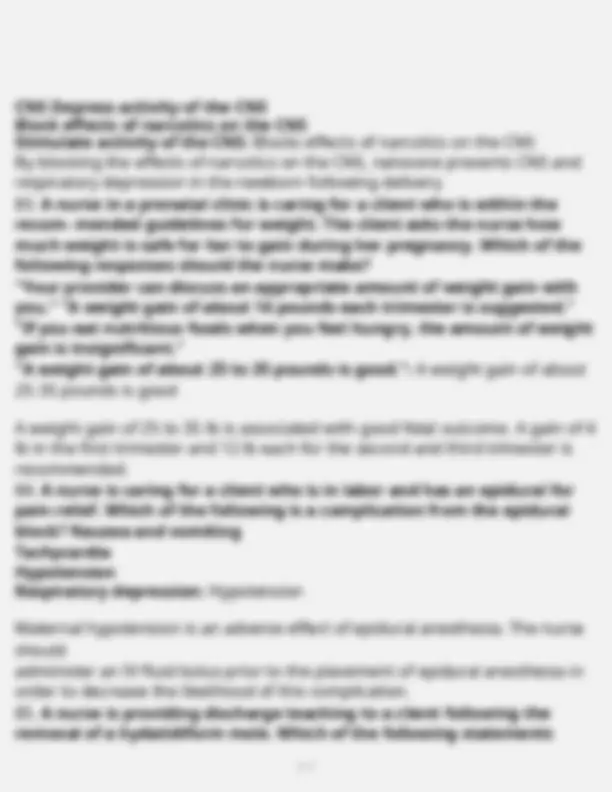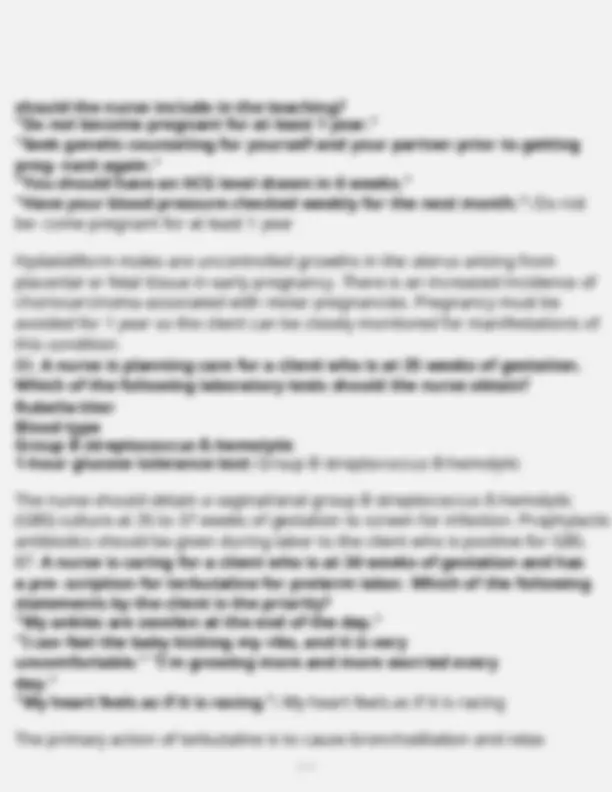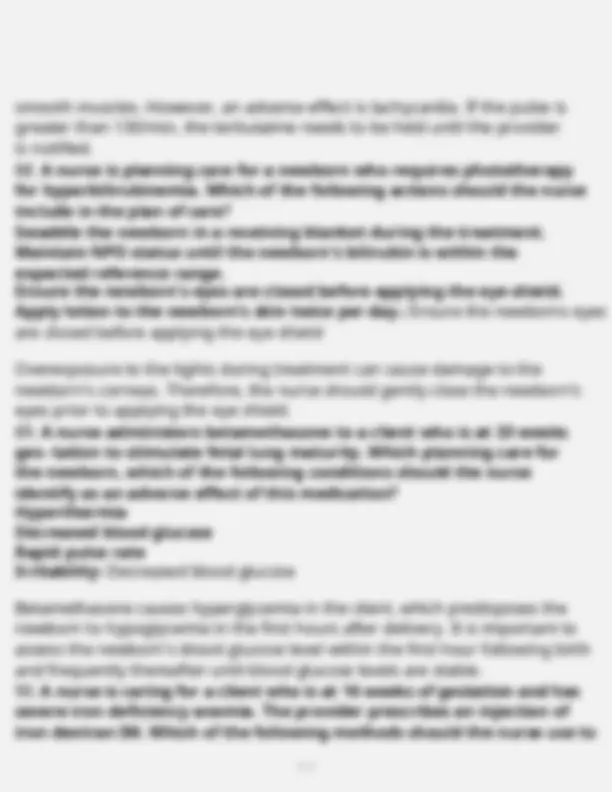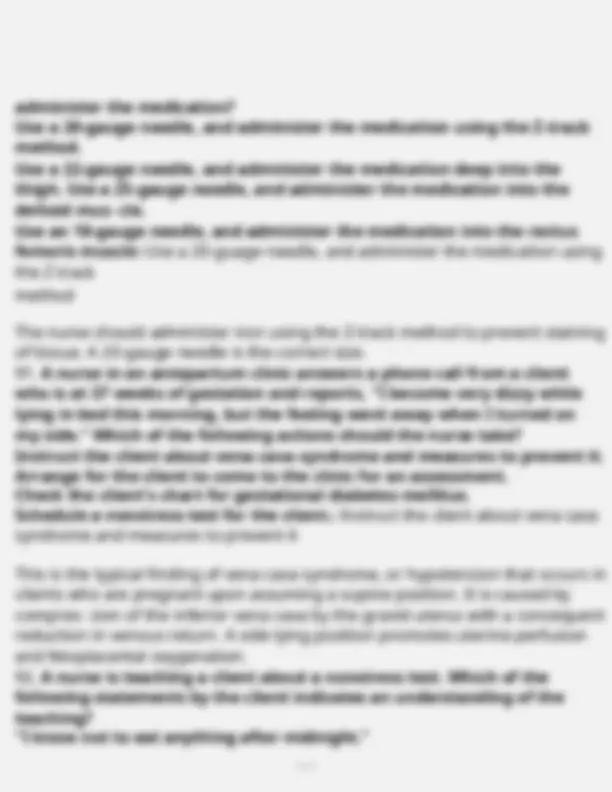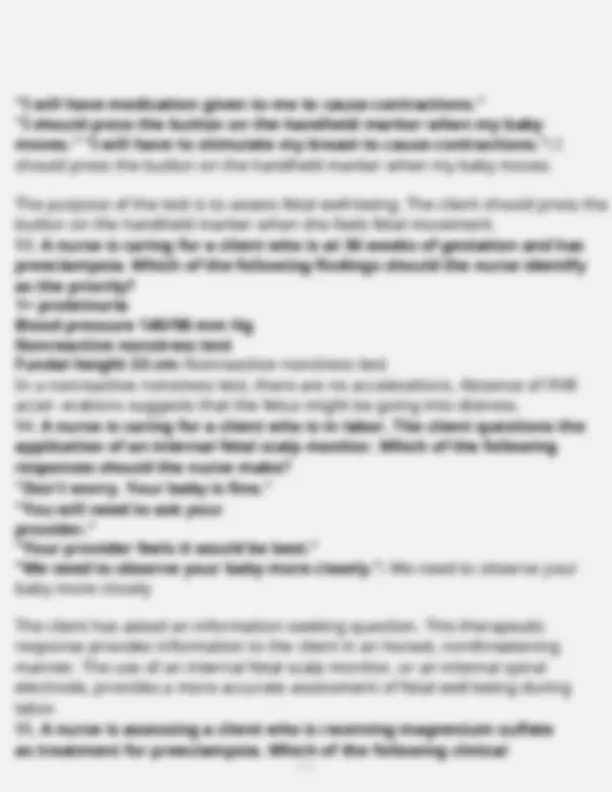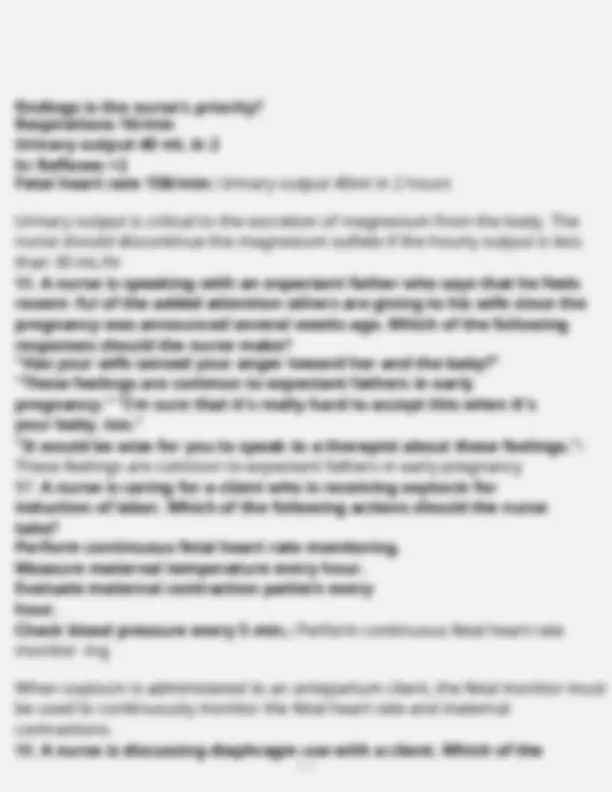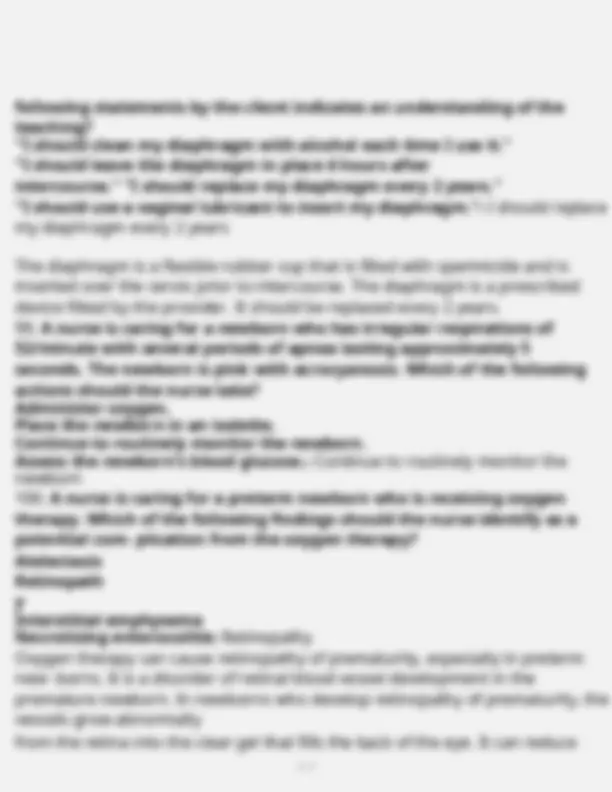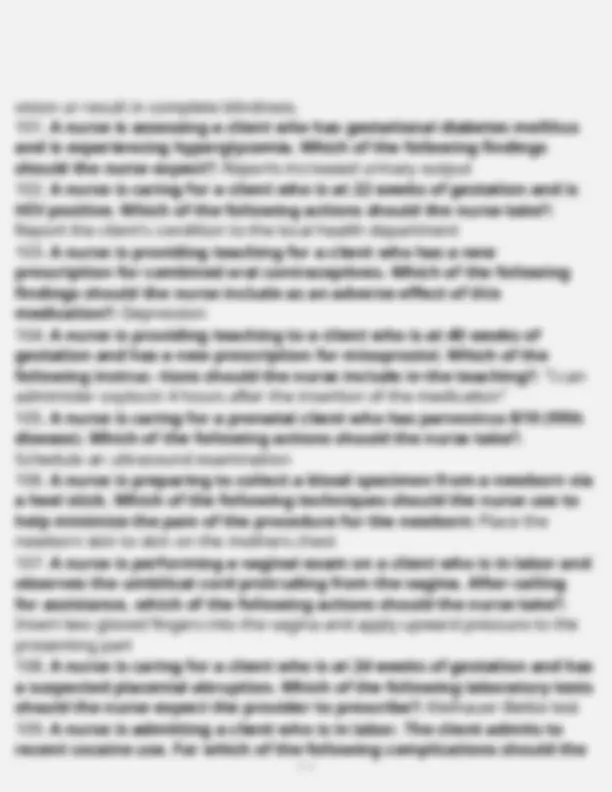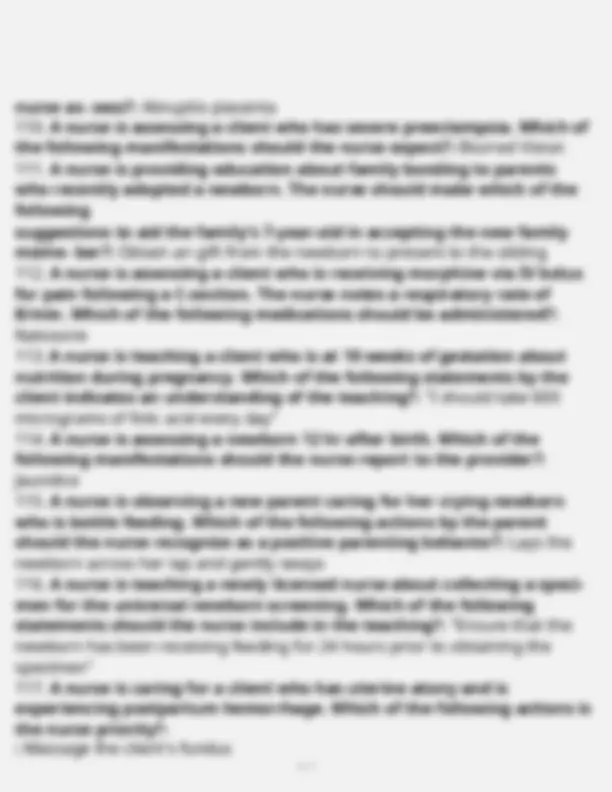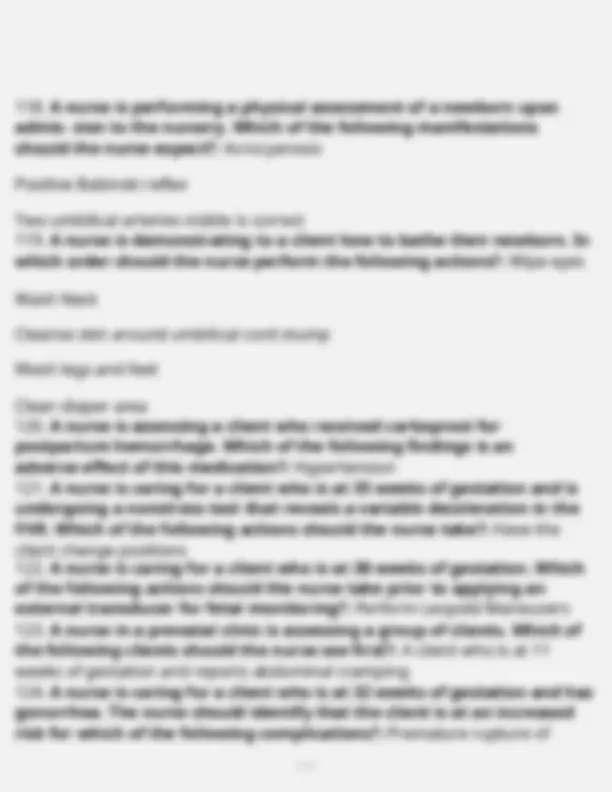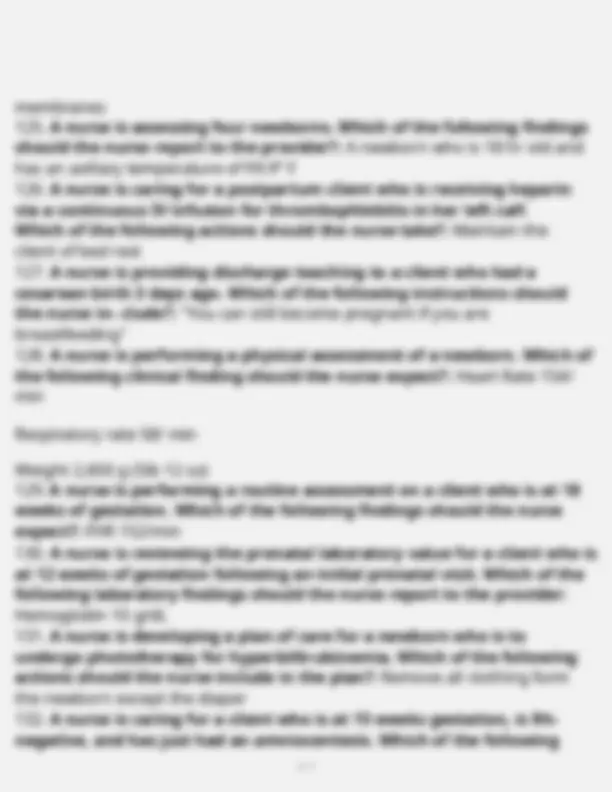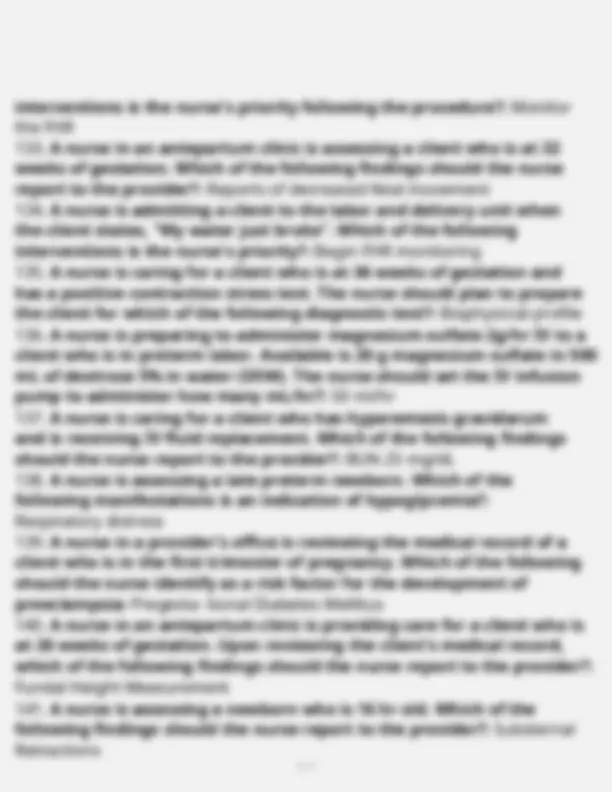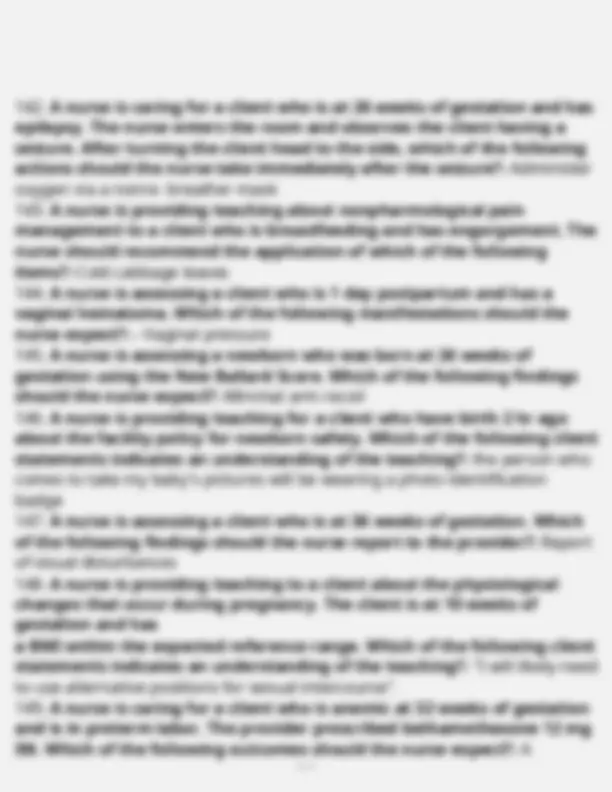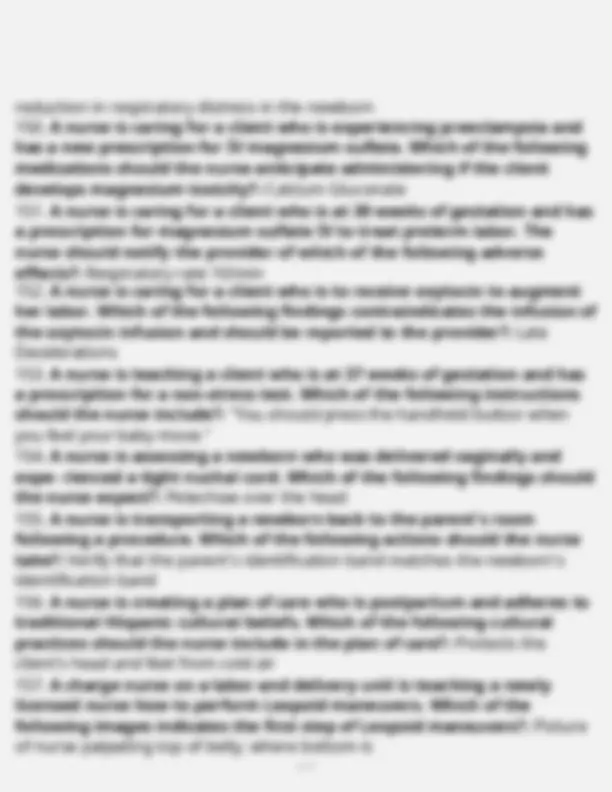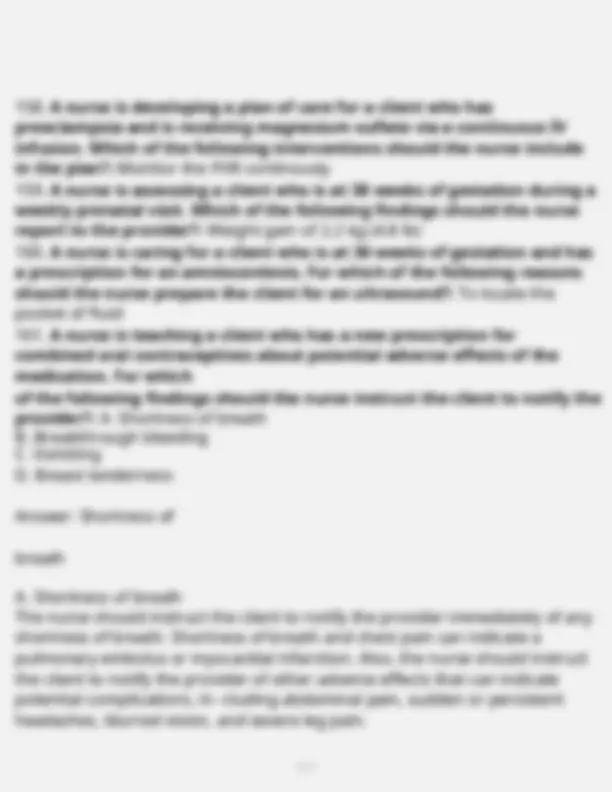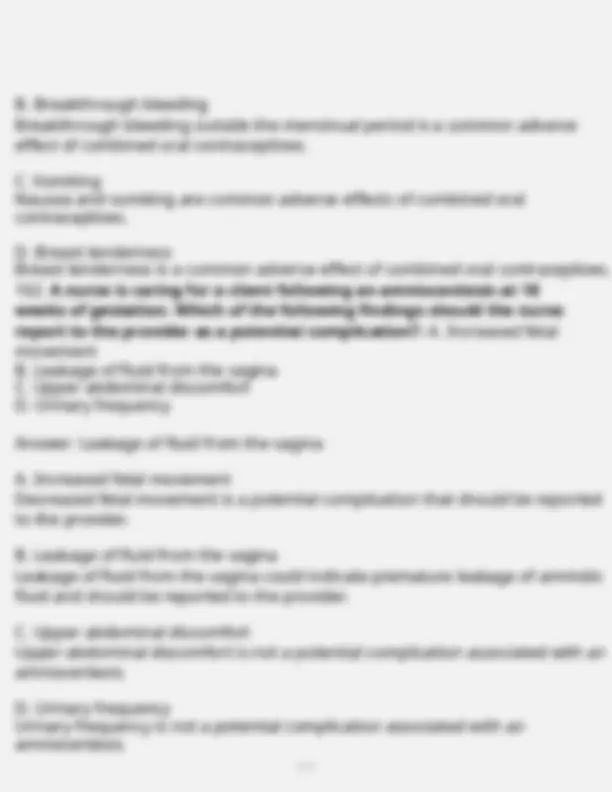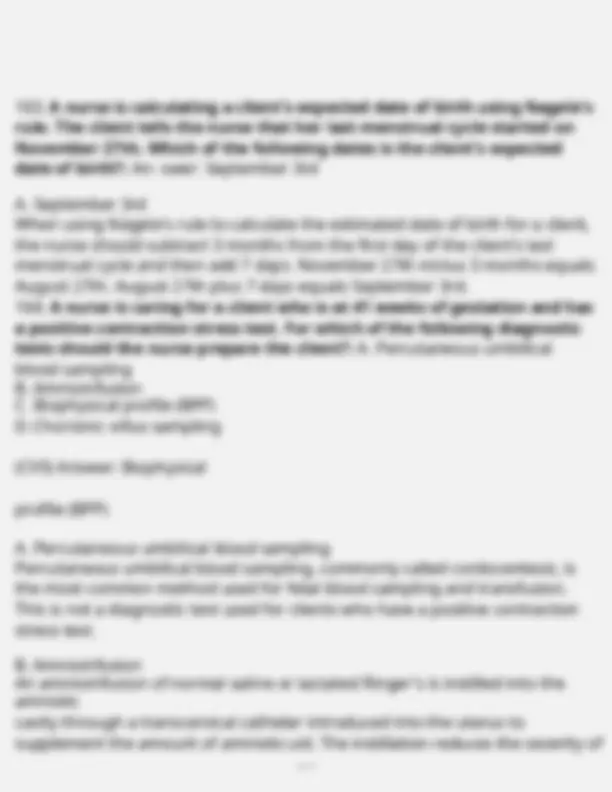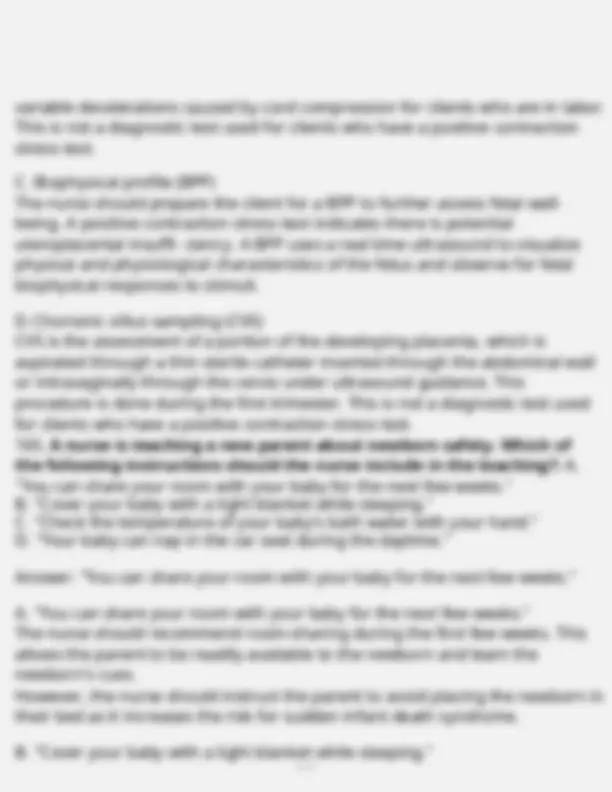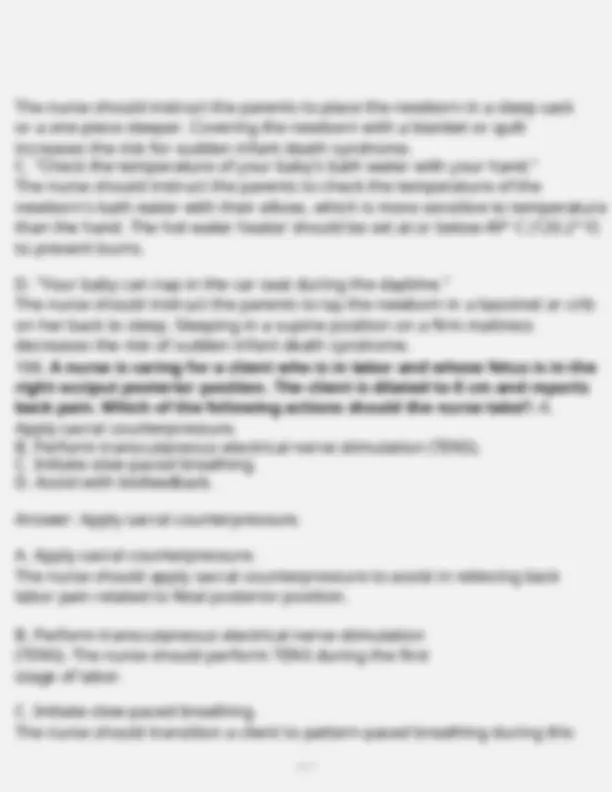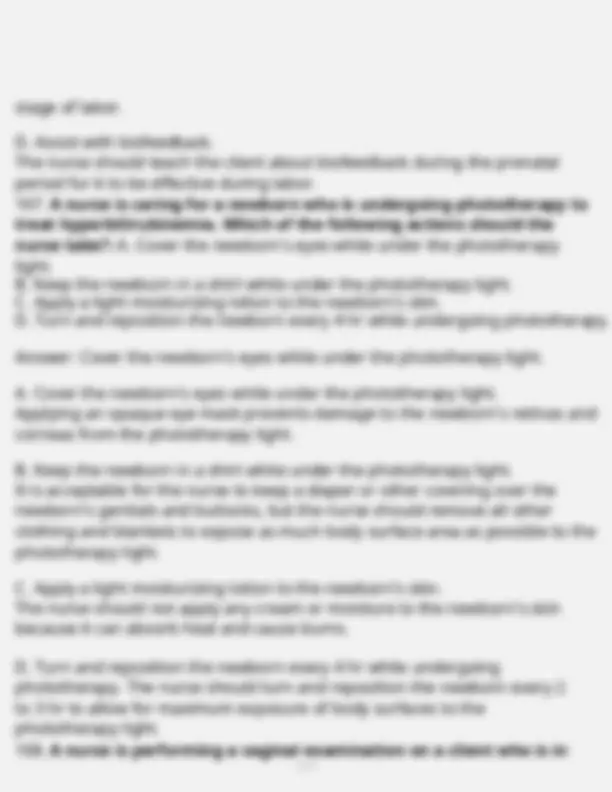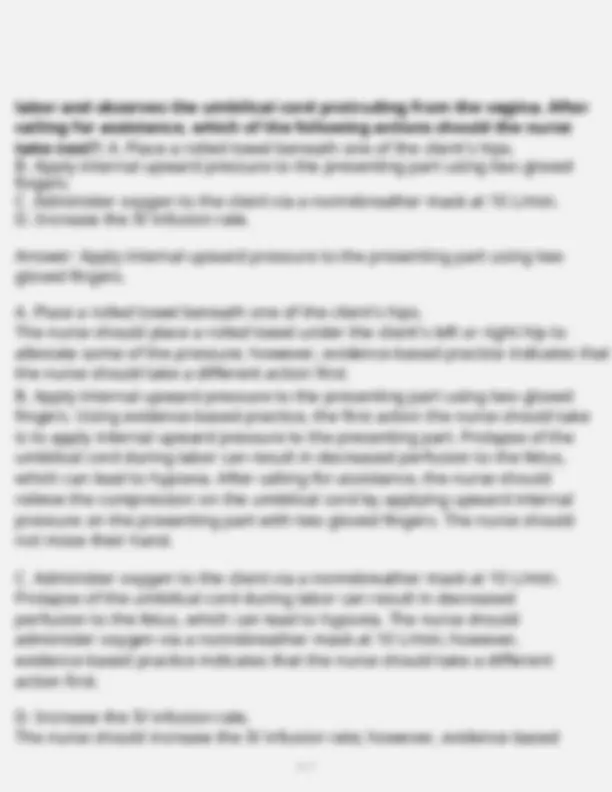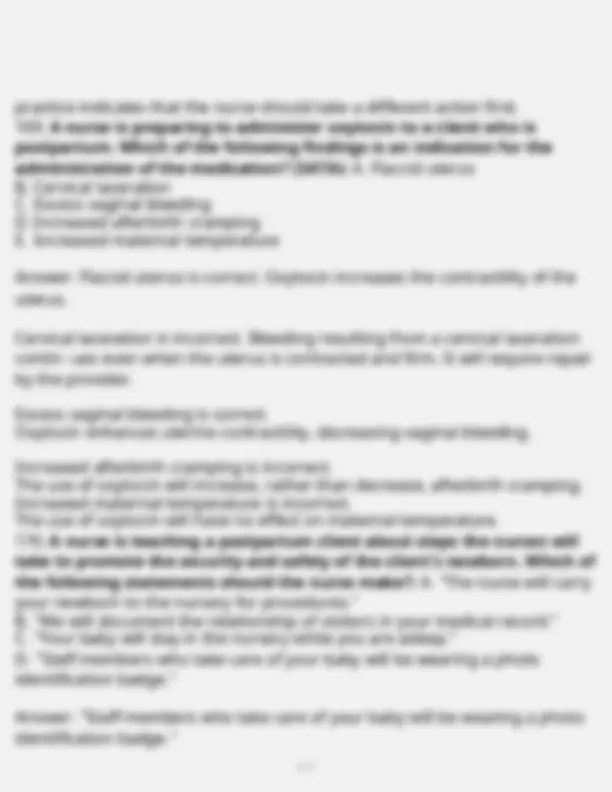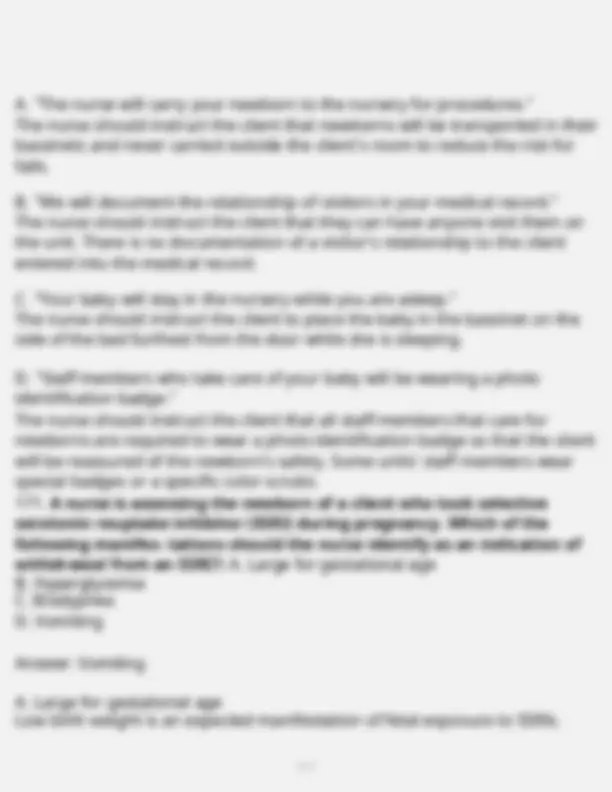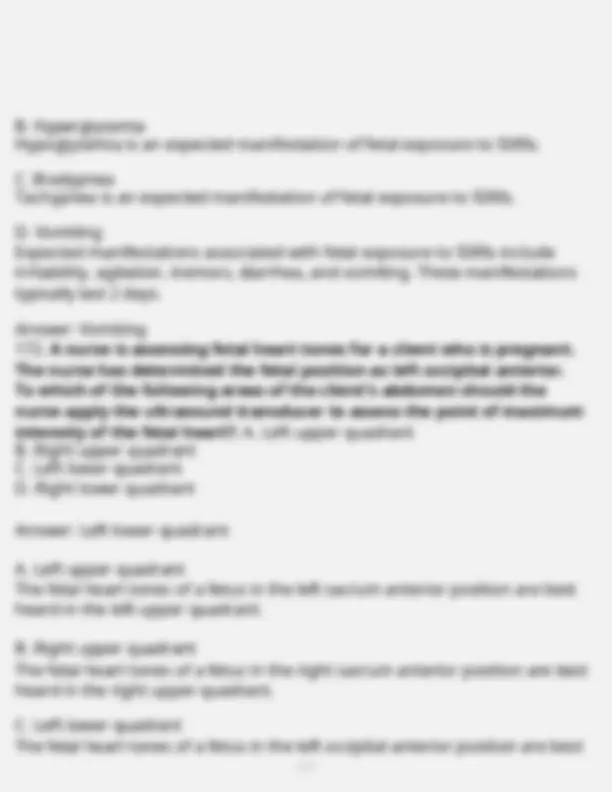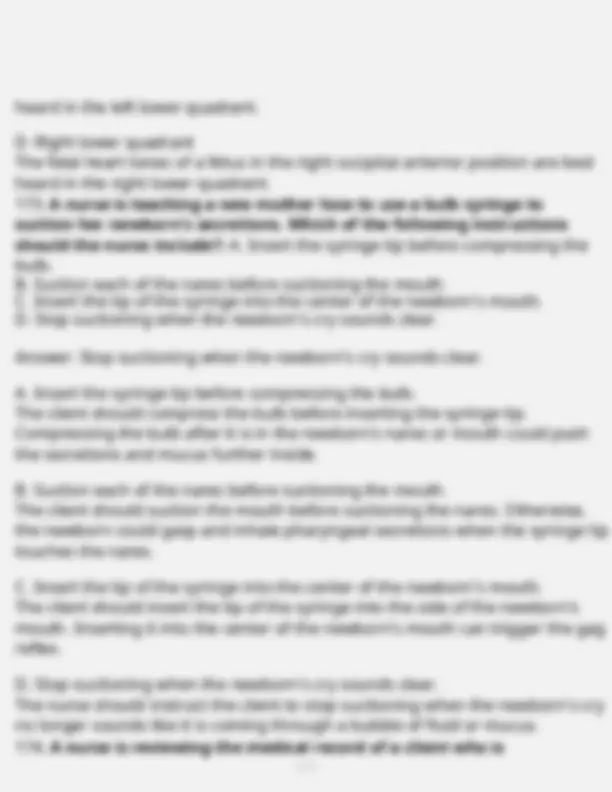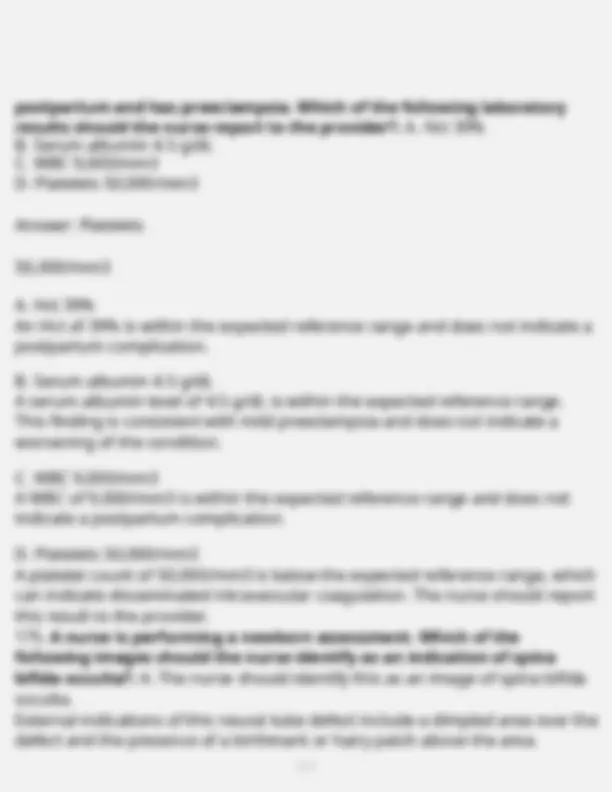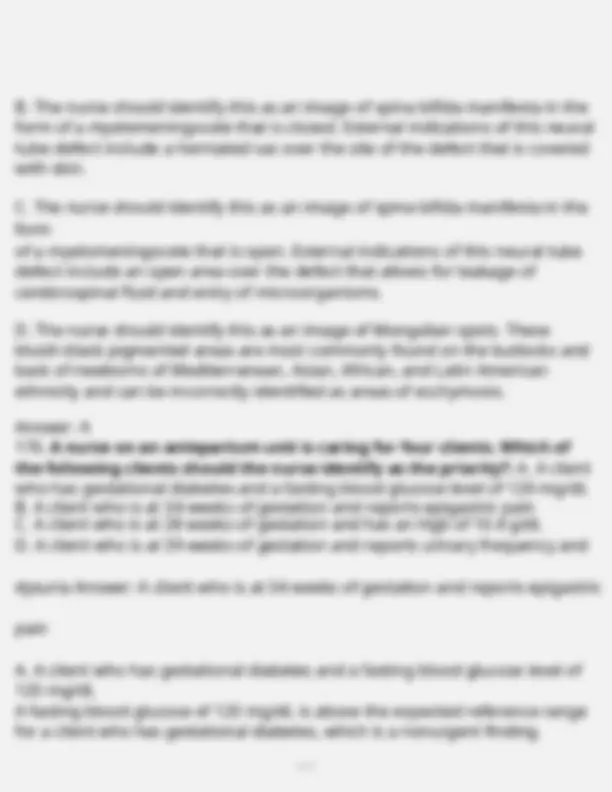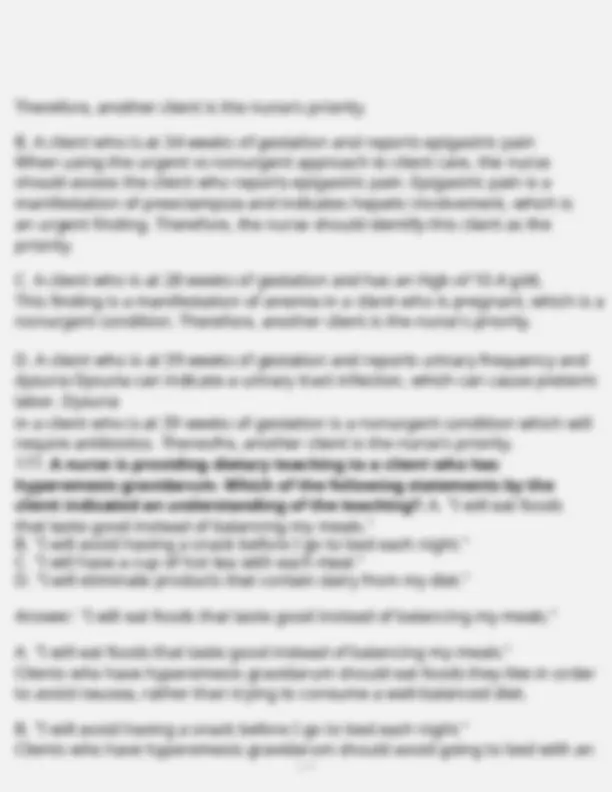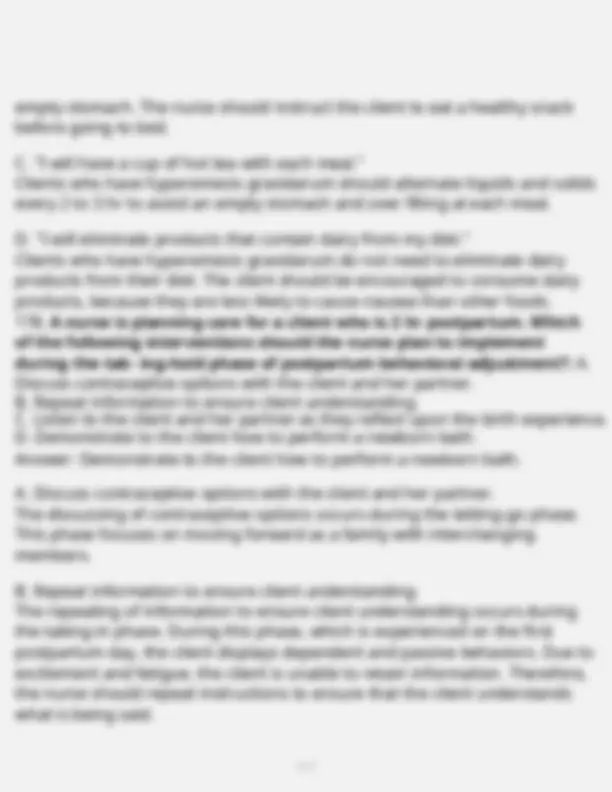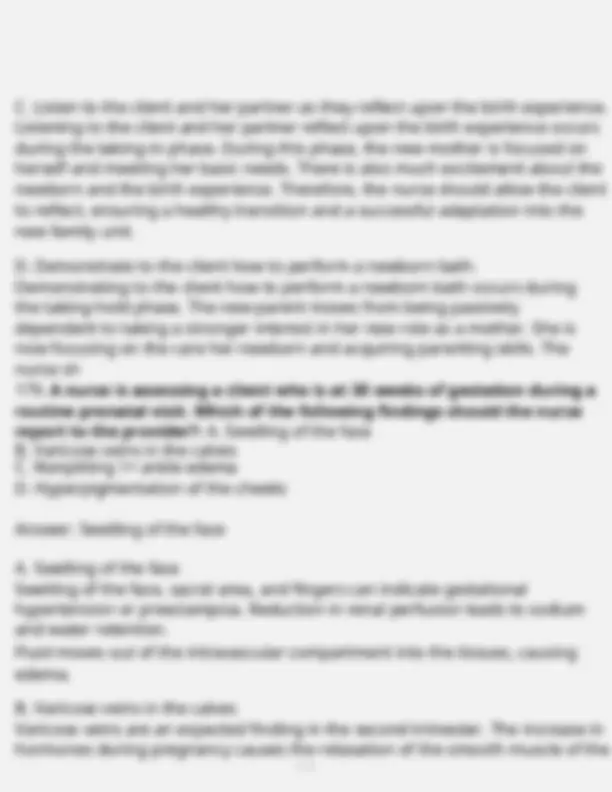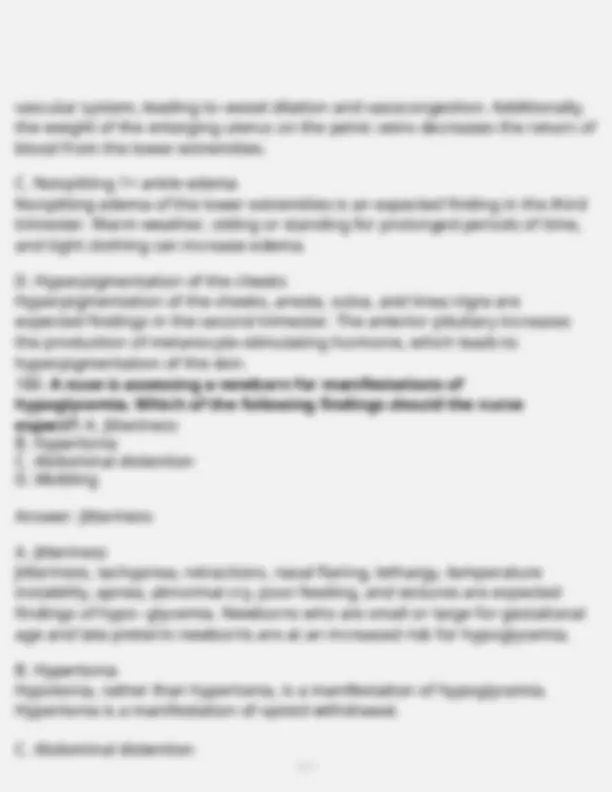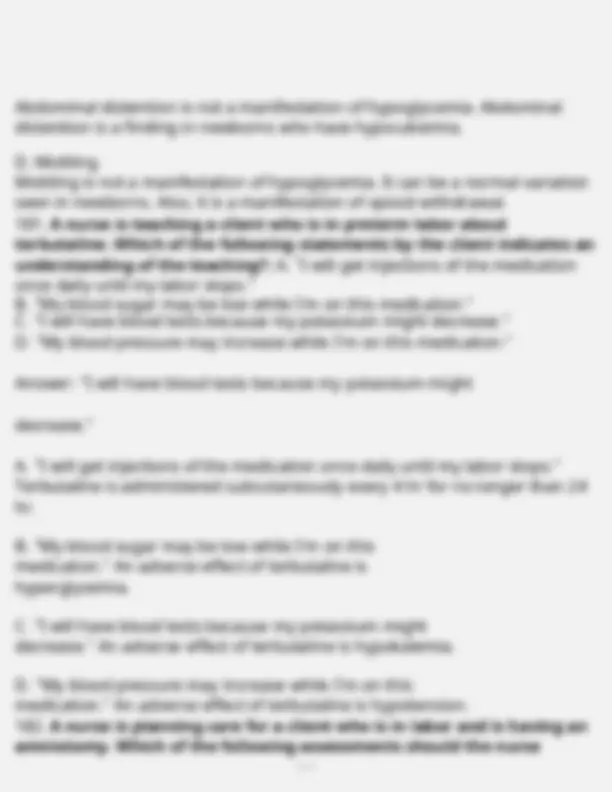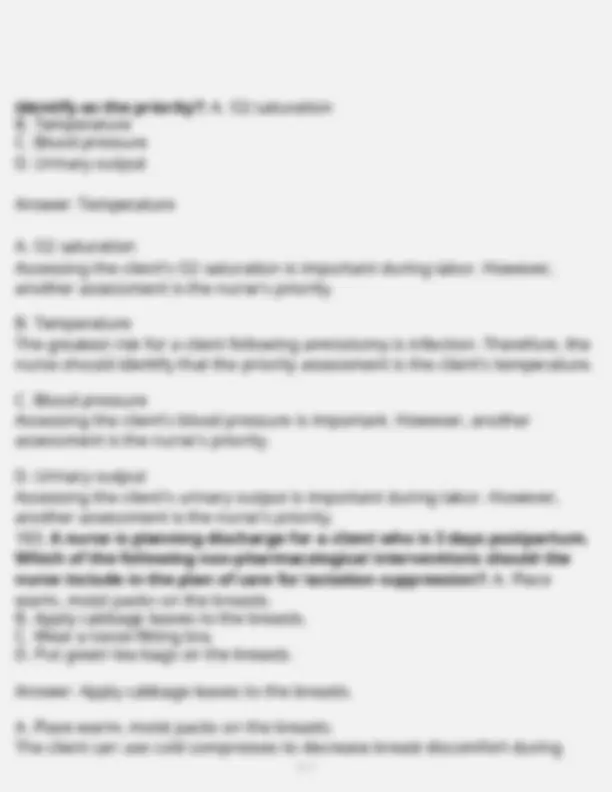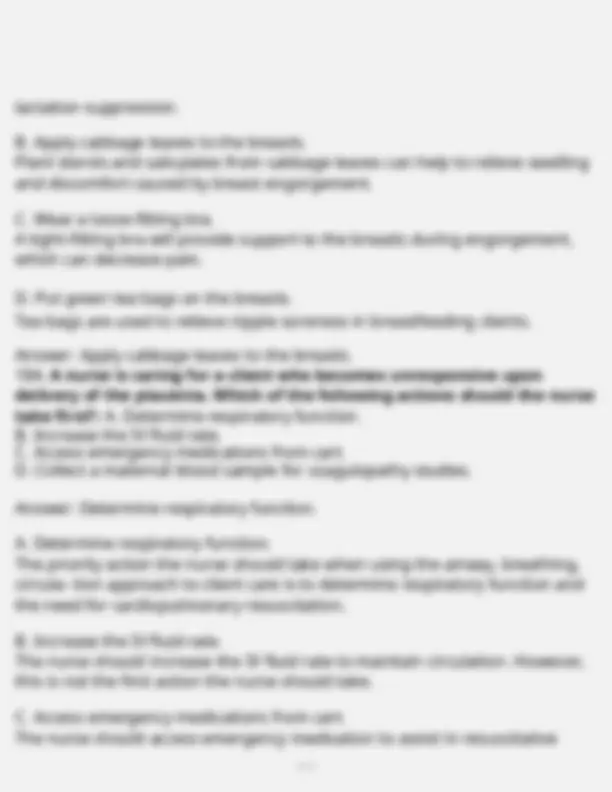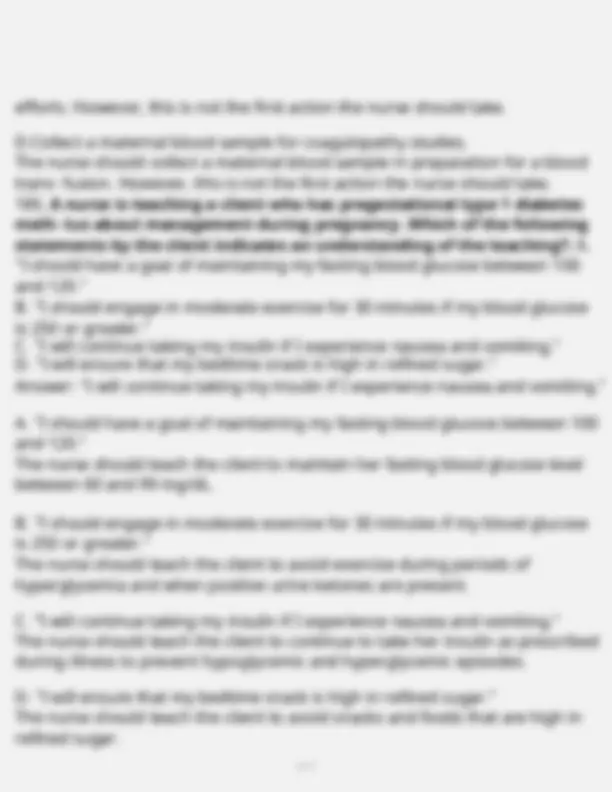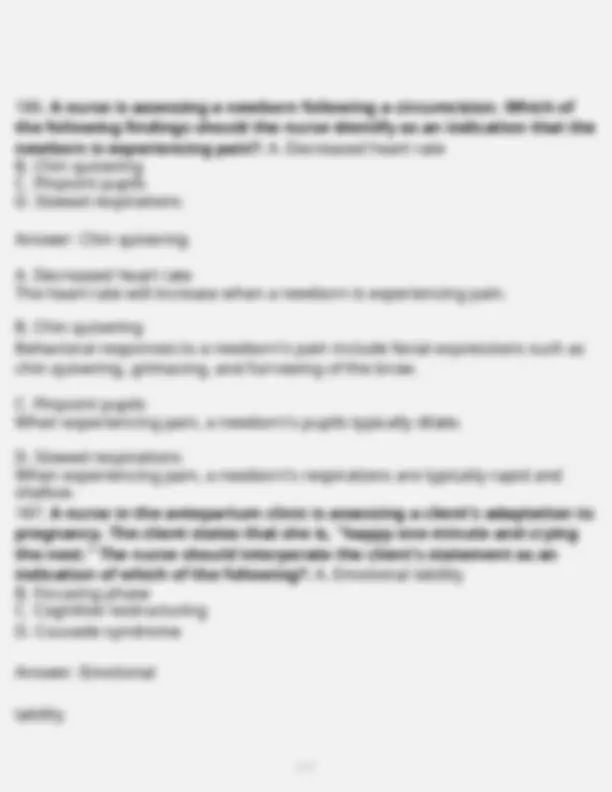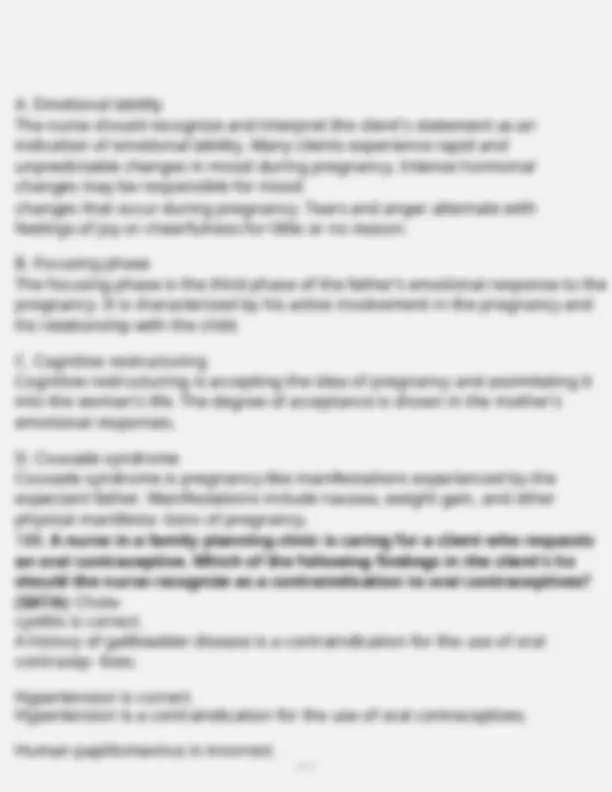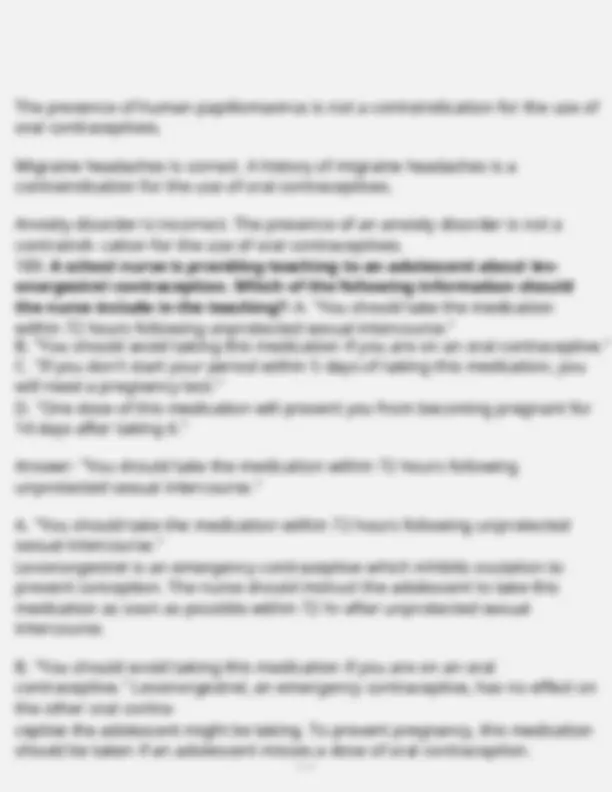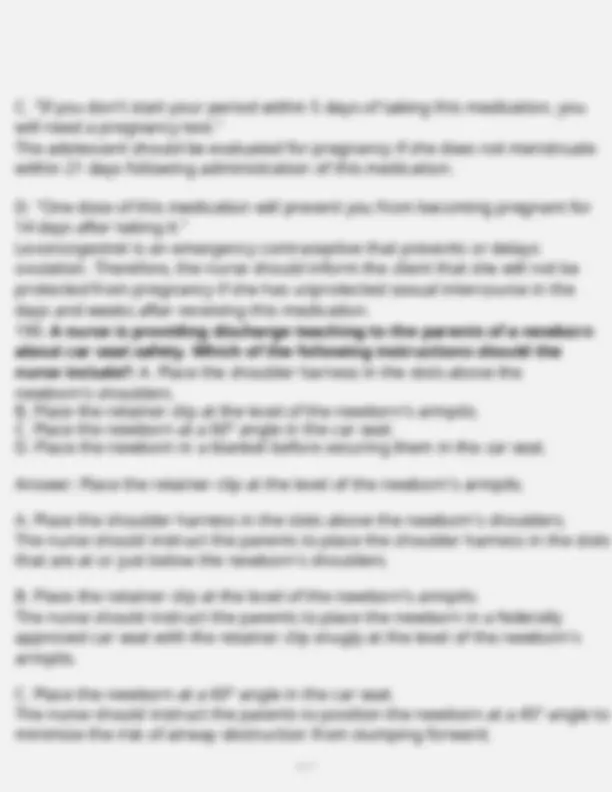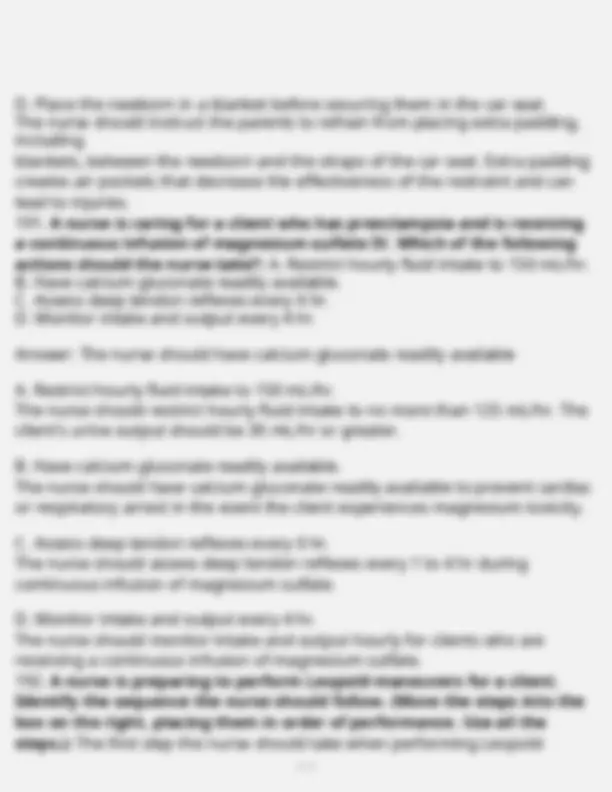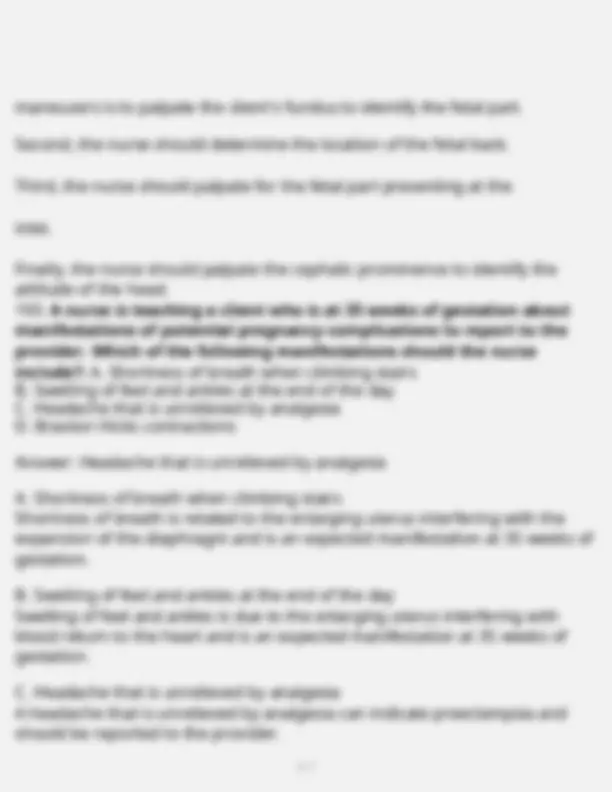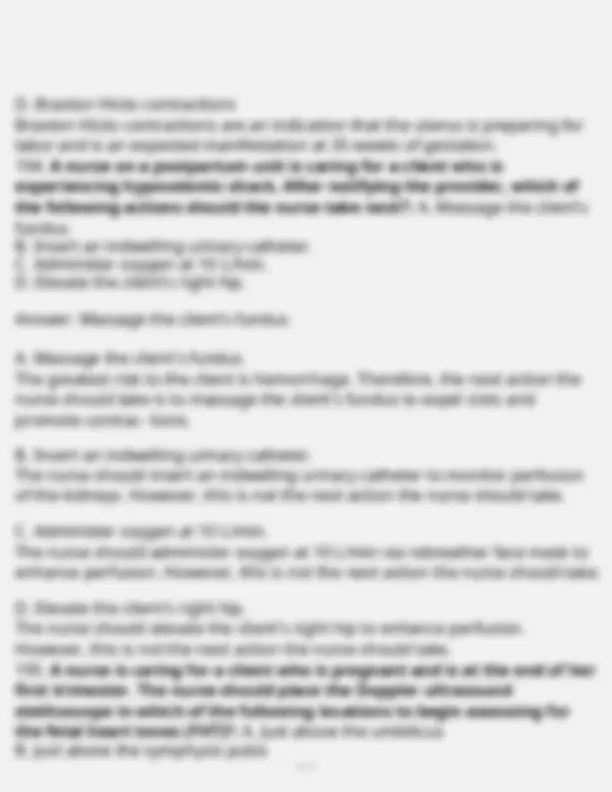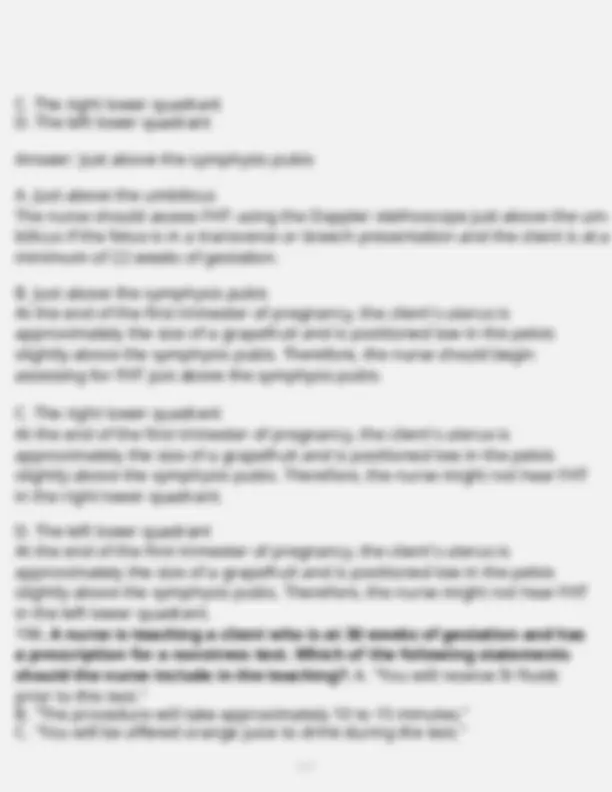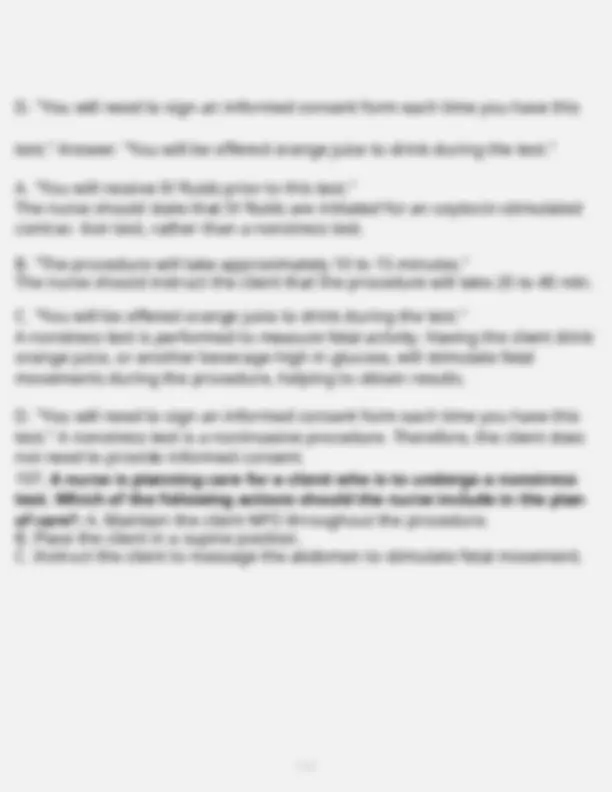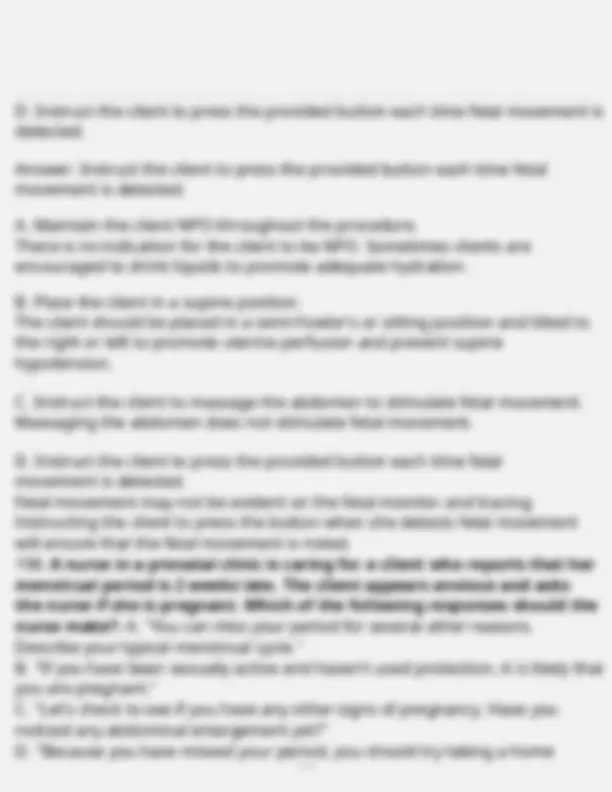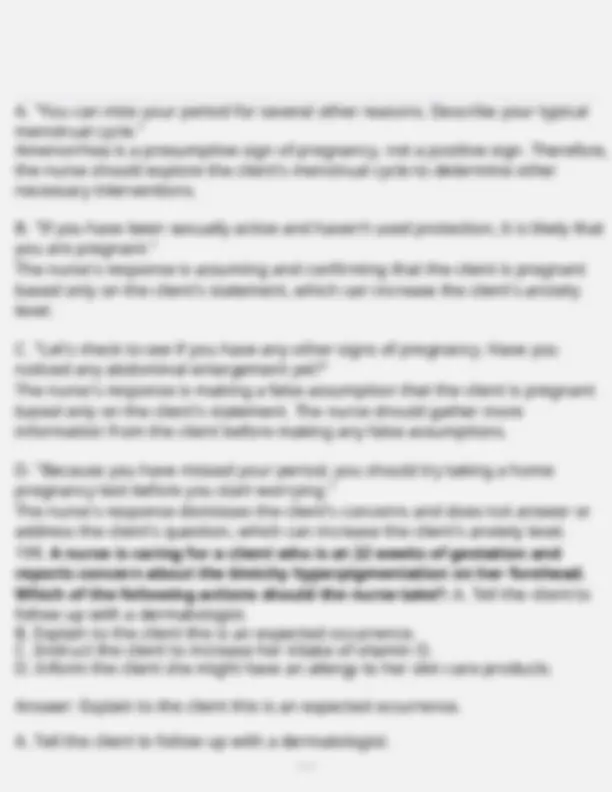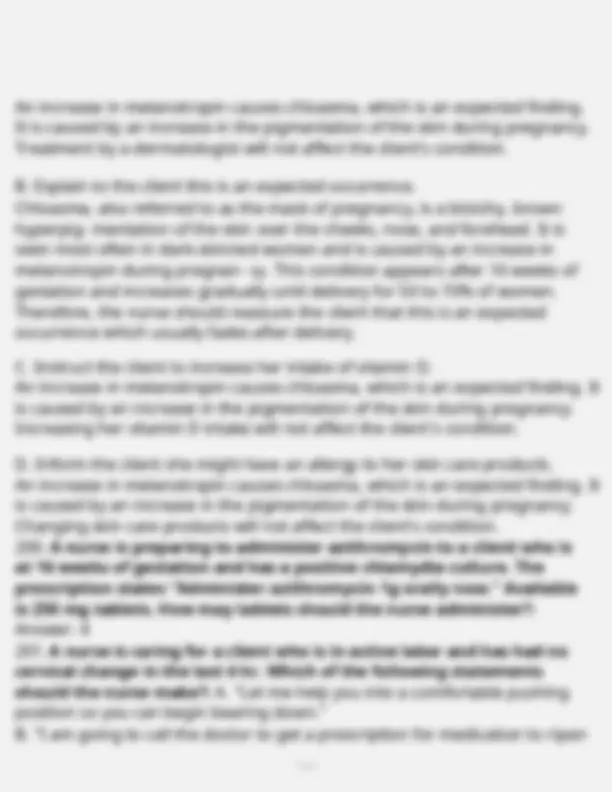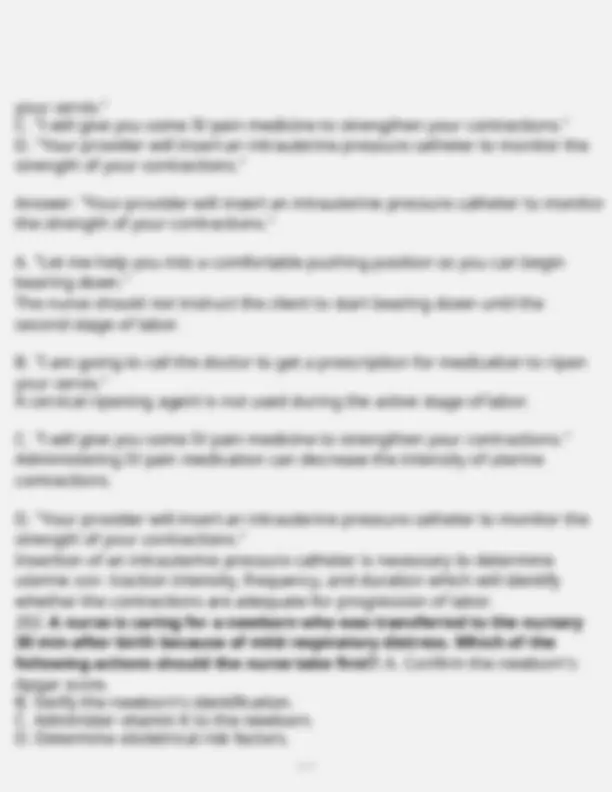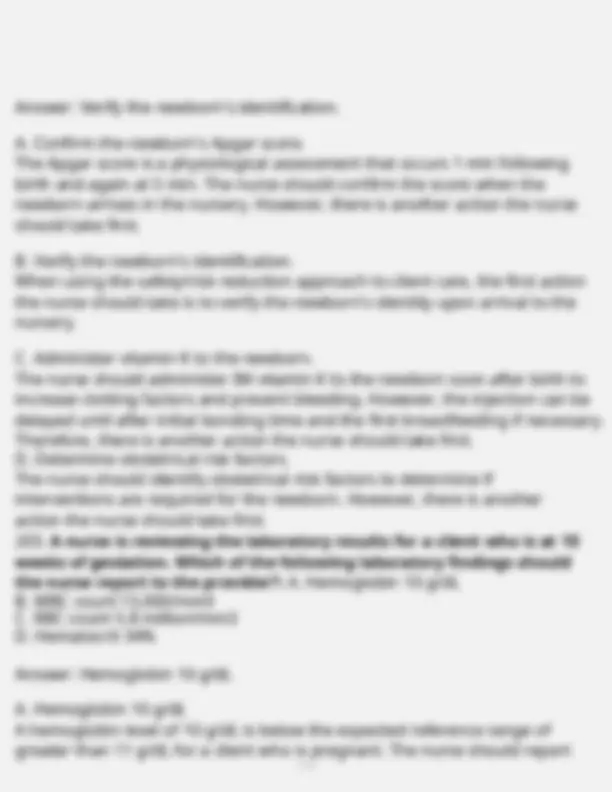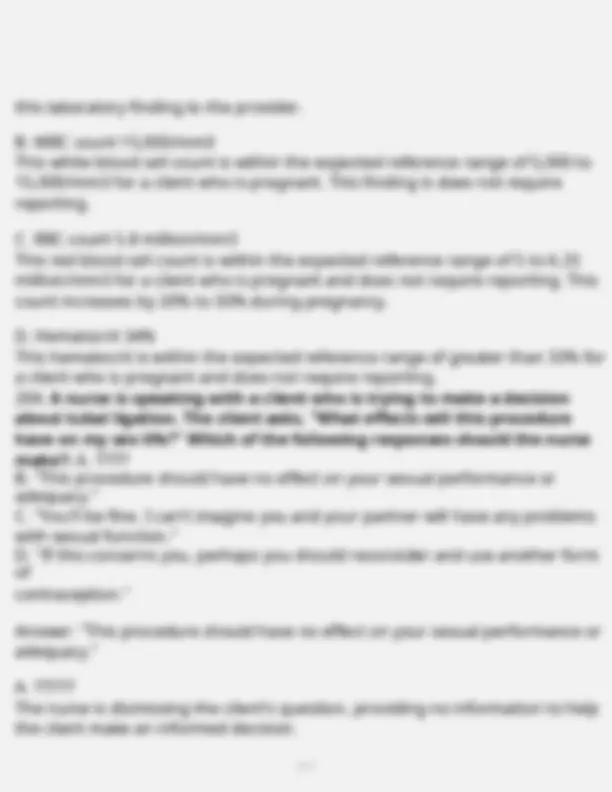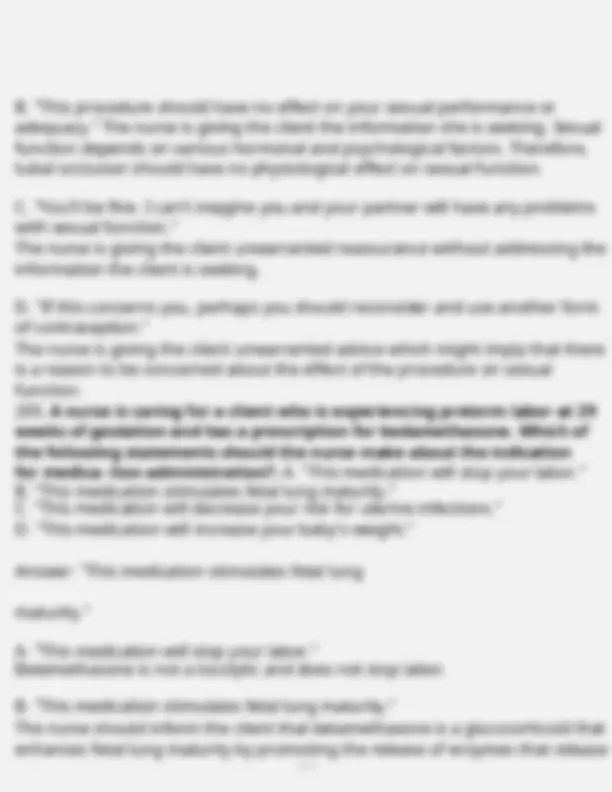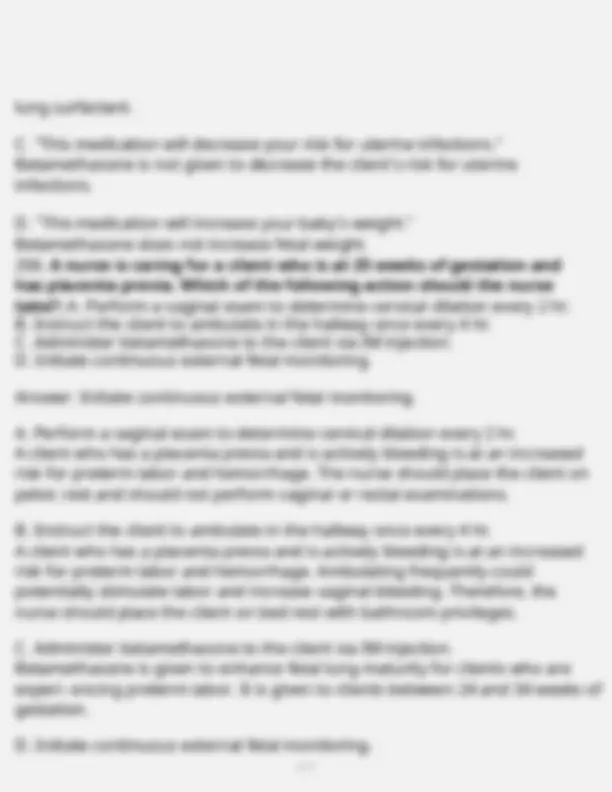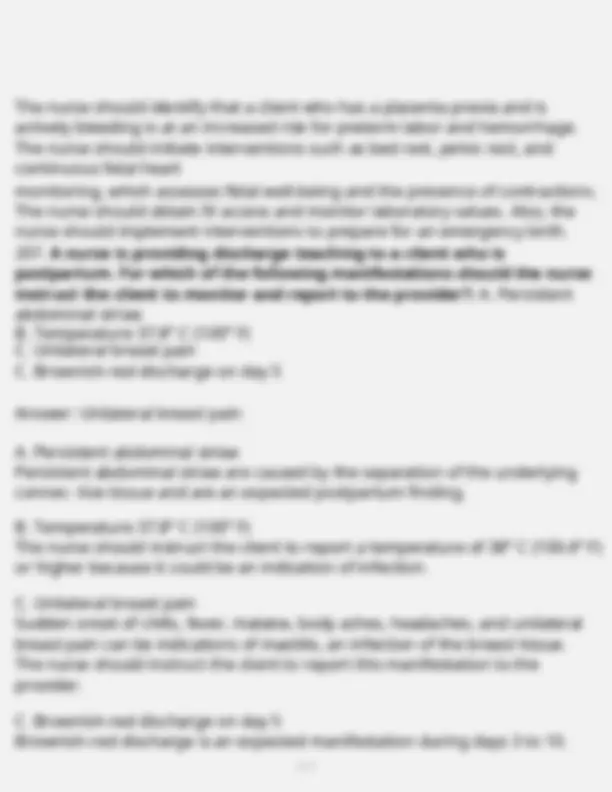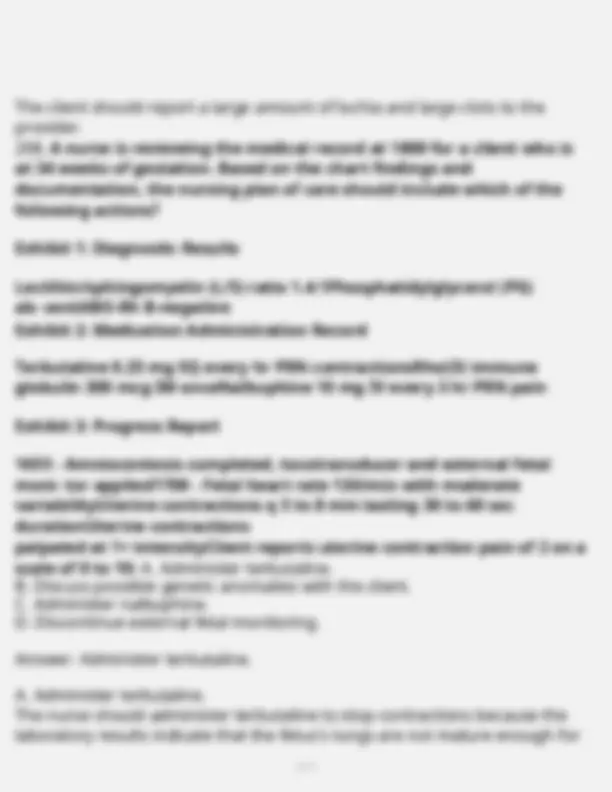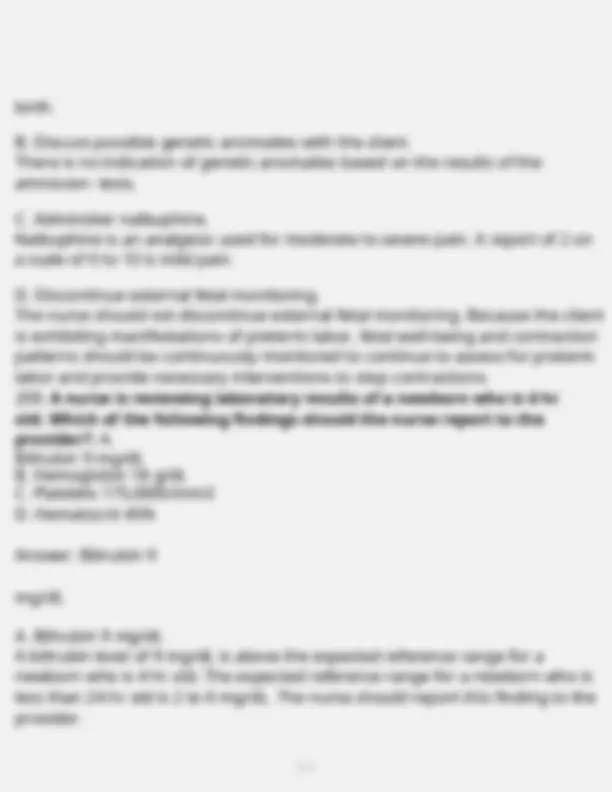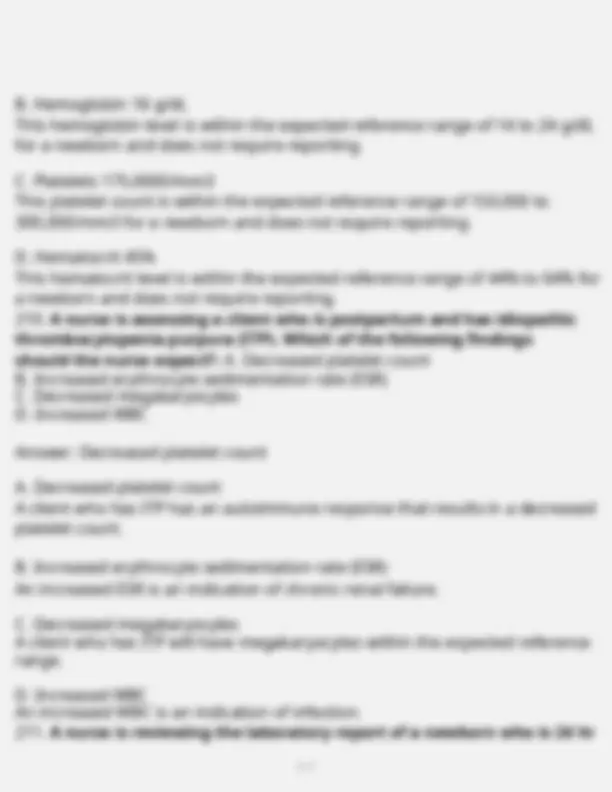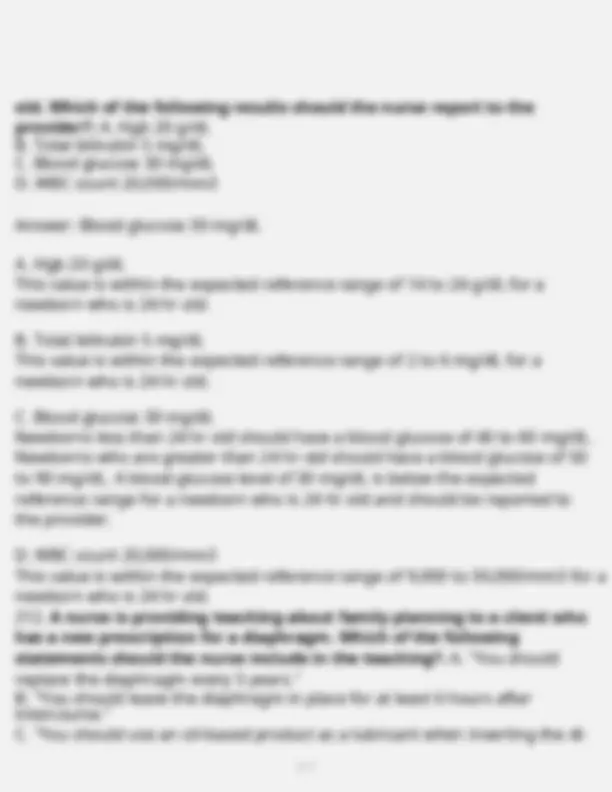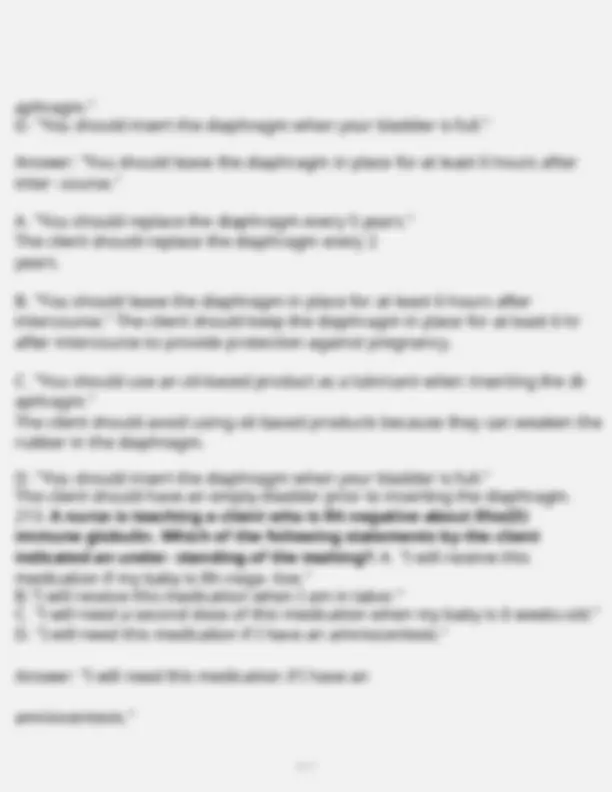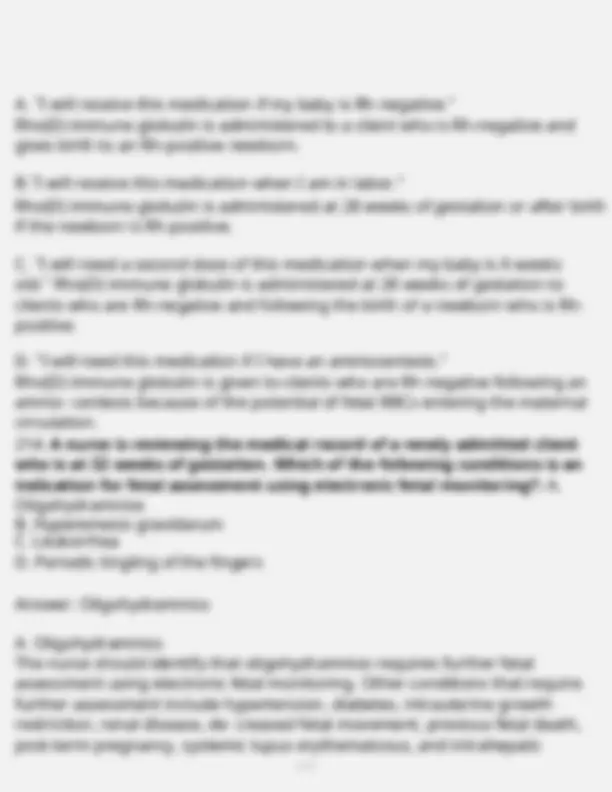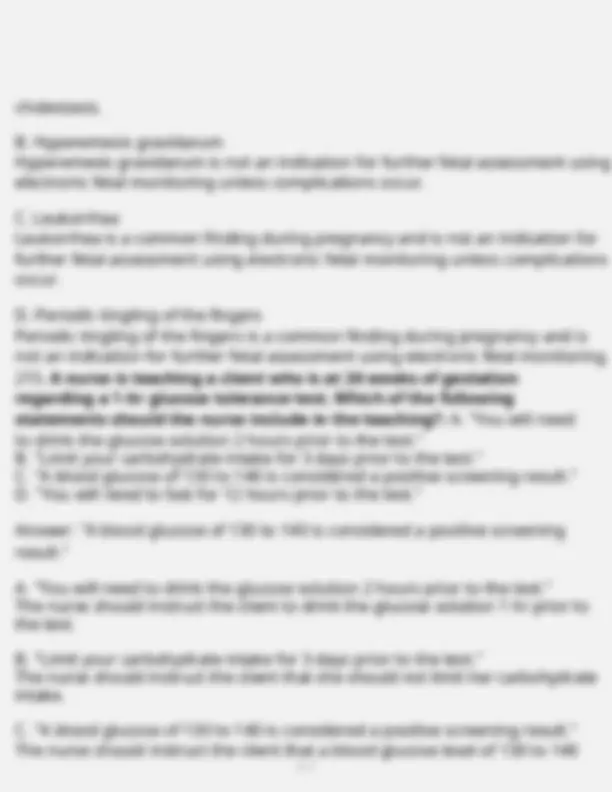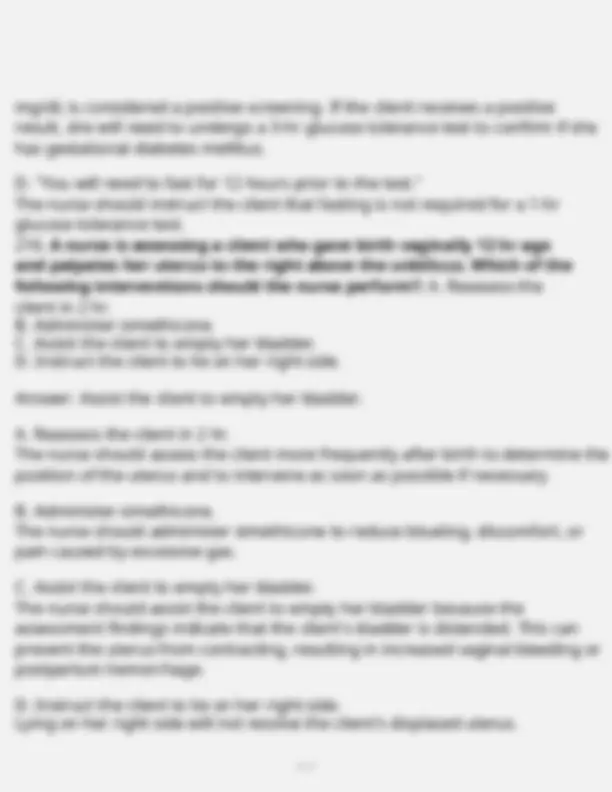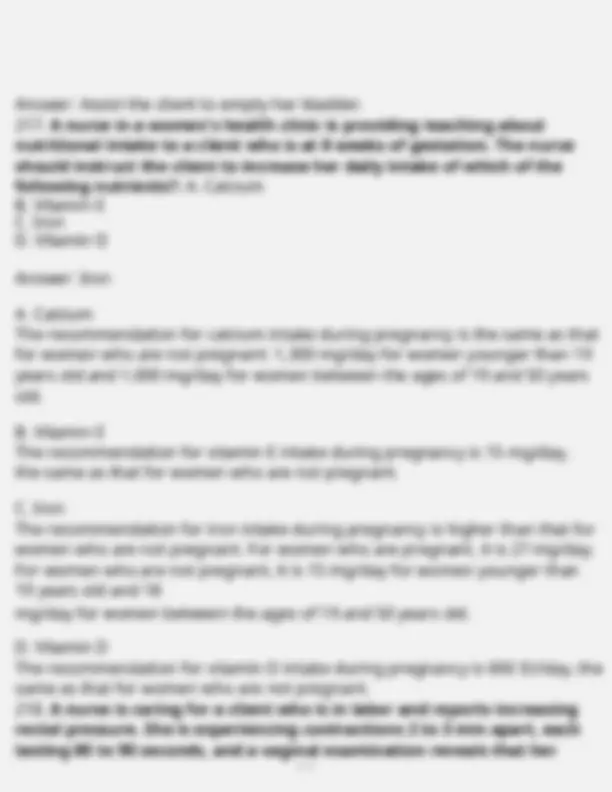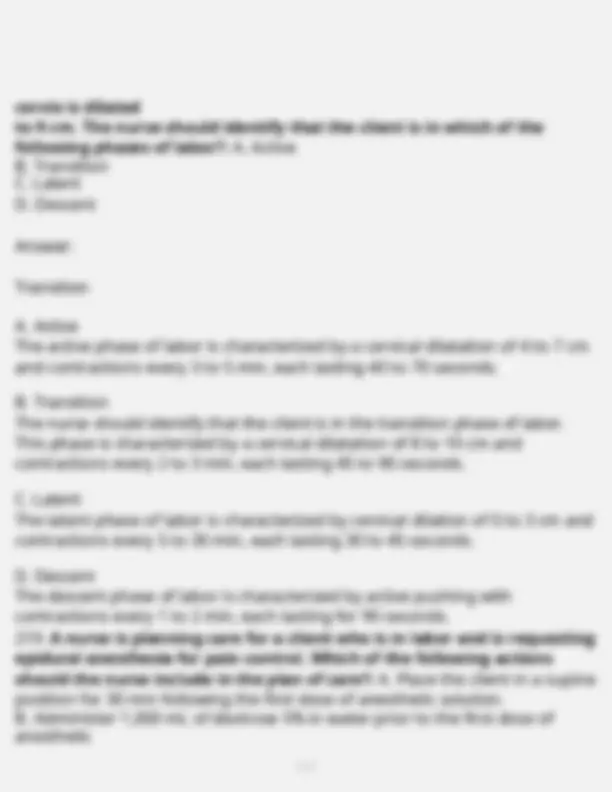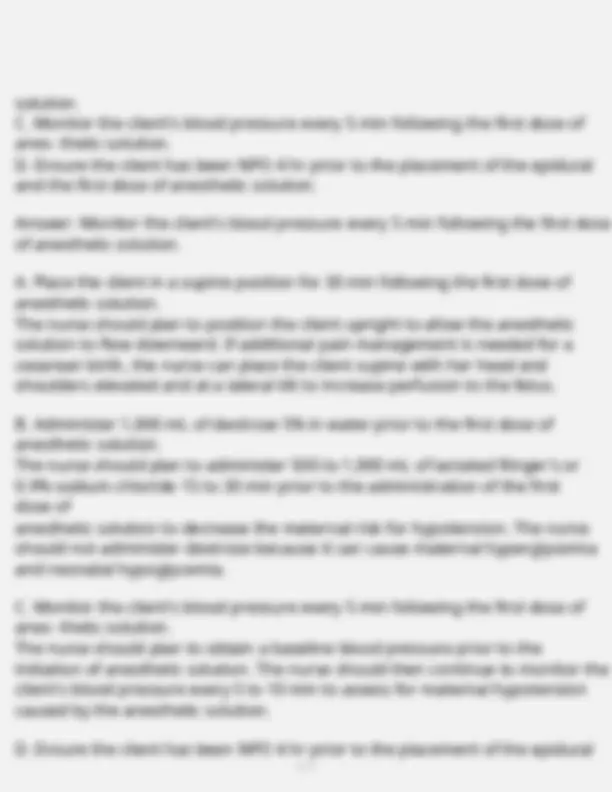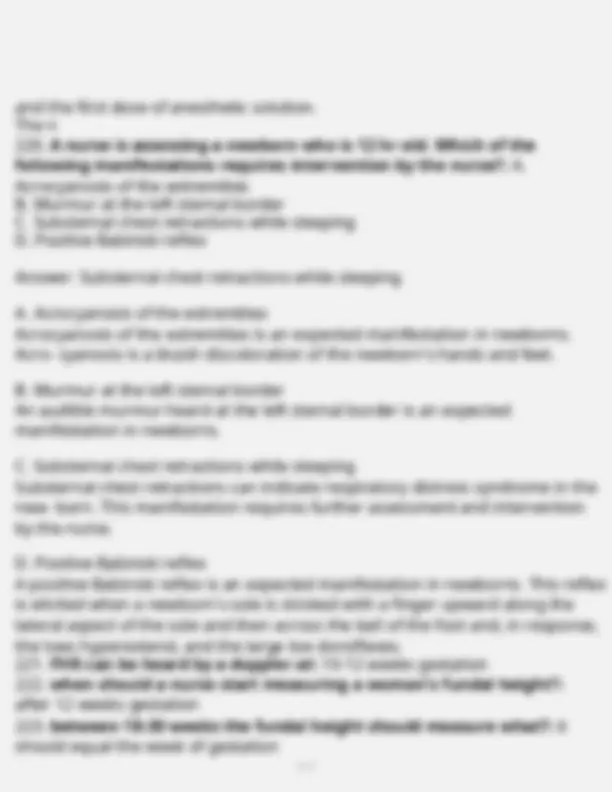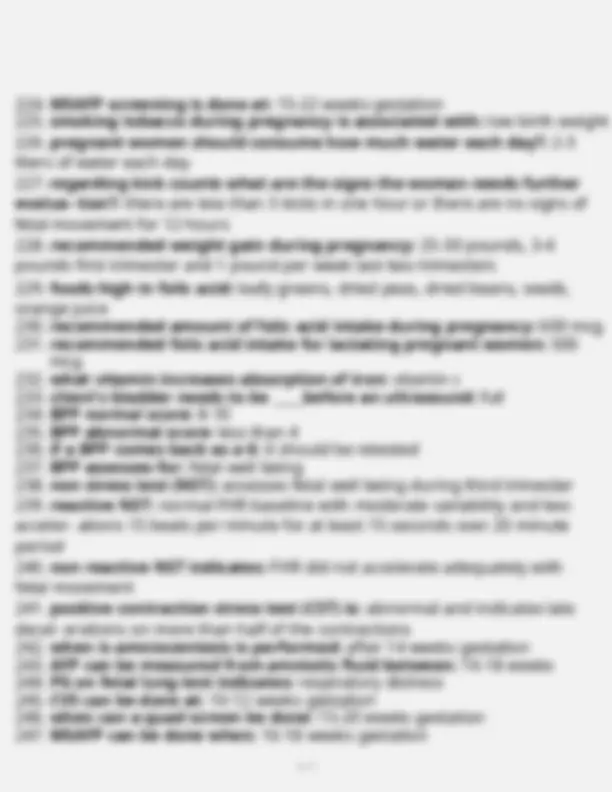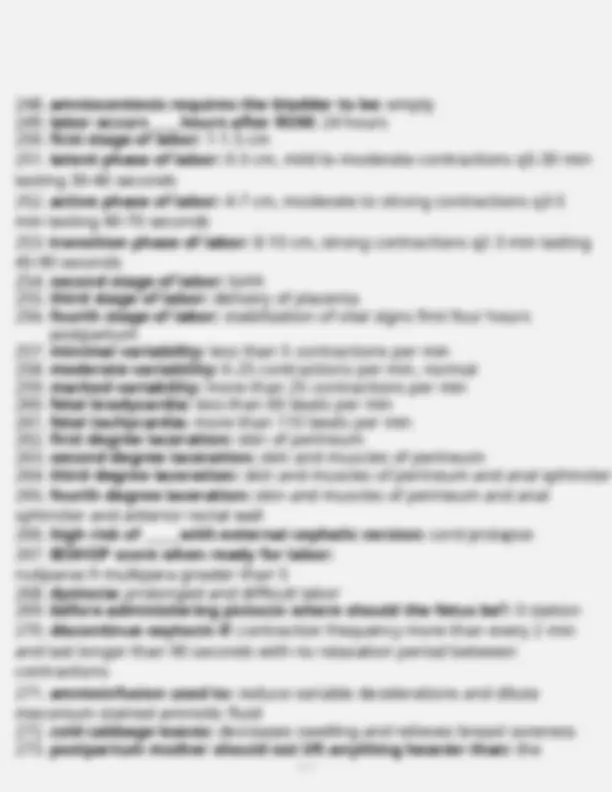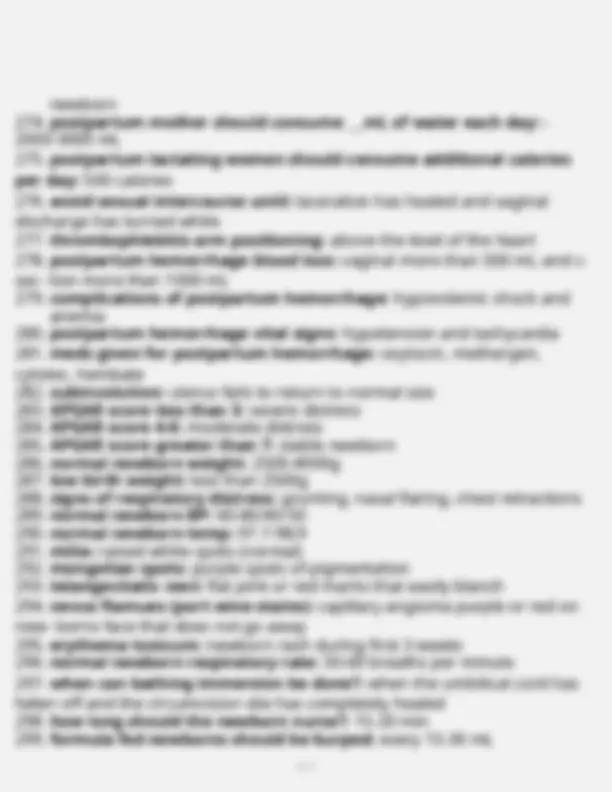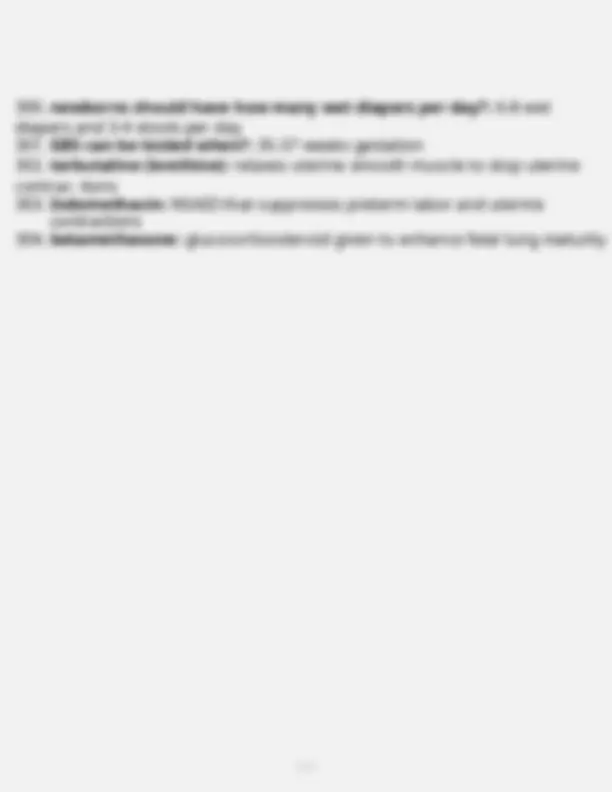Download RN MATERNAL NEWBORN ATI PROCTORED NEWEST 2024-2025 ACTUAL EXAM COMPLETE 304 FREQUENTLY TES and more Exams Nursing in PDF only on Docsity!
RN MATERNAL NEWBORN ATI PROCTORED NEWEST 2024-2025 ACTUAL EXAM COMPLETE 304 FREQUENTLY TESTED QUESTIONS AND CORRECT D TAILED ANSWERS
- A nurse is caring for a client who is at 32 wks gestation and is experiencing preterm labor. What meds should the nurse plan to administer? a. misoprostol b. betamethasone c. poractant alfa d. methylergonovine: b. betamethasone
- A nurse at a prenatal clinic is caring for a client who suspects she may be pregnant and asks the nurse how the provider will confirm her pregnancy. The nurse should inform the client that what lab test will be used to confirm her pregnancy? a. urine test for presence of HCG b. urine test for the presence of HCS c. blood test for presence of estrogen d. blood test for the amount of circulating progesterone: a. urine test for pres- ence of HCG
- A nurse is caring for a client who believes she may be pregnant. What finding should the nurse identify as a positive sign of pregnancy? a. palpable fetal movement b. amenorrhea c. chadwick's sign d. positive pregnancy test: a. palpable fetal movement
- A nurse is caring for a client who has oligohydraminios. What fetal anom- alies should the nurse expect? a. renal agenesis b. atrial septal defect c. spina bifida
d. hydrocephalus: a. renal agenesis
- A nurse is assessing a client who is at 37 wks gestation and has a suspected pelvic fracture due to blunt abd trauma. What findings should the nurse expect? a. uterine contractions b. bradycardia c. seizures d. bradypnea: a. uterine contractions The nurse should expect the client to be experiencing uterine contractions due to abdominal trauma.
- A nurse is assessing a client who is at 12 wks gestation and has hydatidi- form mole. What findings should the nurse expect? a. hypothermia b. dark brown vaginal discharge c. fetal heart tones d. decreased urinary output: b. dark brown vaginal discharge A hydatidiform mole, or a molar pregnancy, is a benign proliferative growth of the chorionic villi, which gives rise to multiple cysts. The products of conception transform into a large number of edematous, fluid-filled vesicles. As cells slough off the uterine wall, vaginal discharge is usually dark brown and can contain grapelike clusters.
- A nurse is assessing a client who is at 35 weeks of gestation and has mild gestational HTN. What finding should the nurse identify as the priority? a. 480 mL urine output in 24 hrs b. 1+ protein in the urine c. +2 edema of the feet d. BP 144/92: a. 480 mL urine output in 24 hrs When using the urgent vs. nonurgent approach to client care, the nurse should determine that the priority finding is 480 mL of urine output in 24 hr because
experiencing uterine tachysystole.
- A nurse is caring for a client who is in active labor and has meconium staining of the amniotic fluid. The nurse notes a reassuring FHR tracing from the external fetal monitor. What action should the nurse take? a. prepare the client for emergency c-section b. perform endotrach suctioning as soon as the fetal head is delivered c. prepare equipment needed for newborn resuscitation d. prepare the client for an ultrasound exam: c. prepare equipment needed for newborn resuscitation The nurse should ensure that all supplies and equipment needed for resuscitation of the newborn are readily available for every delivery. Endotracheal suctioning is recommended in cases of meconium staining only if the newborn has poor respiratory effort, decreased muscle tone, and bradycardia after delivery.
- A nurse is reviewing the medical record of a client who is at 33 wks gestation and has placenta previa and bleeding. What scripts should the nurse clarify with the provider? a. insert a large-bore IV catheter b. perform a vaginal exam c. perform continuous external fetal monitoring d. obtain a blood sample for lab testing: b. perform a vaginal exam When a client has a placenta previa, the placenta implants in the lower part of the uterus and obstructs the cervical os (the opening to the vagina). The nurse should clarify this prescription because any manipulation can cause tearing of the placenta and increased bleeding.
- A nurse is caring for a client who is at 37 wks gestation and is undergoing a nonstress test. The FHR is 130 without accelerations for the past 10 min. What action should the nurse take? a. request a script for an internal fetal scalp electrode b. auscultate the FHR with a doppler transducer c. report the nonreactive test result to the provider immediately
d. use vibroacoustic stim on the client's abd for 3 seconds: d. use vibroacoustic stim on the client's abd for 3 seconds The nurse should use a vibroacoustic stimulator on the client's abdomen to elicit fetal activity because the fetus is most likely sleeping. Fetal movement should cause accelerations in the FHR.
- A nurse is reviewing lab results for a client who is at 37 wks gestation. The nurse notes that the client is rubella non-immune, positive for group A beta-hemolytic strep, and has a blood type O neg. What action should the nurse take? a. instruct the client to obtain a rubella immunization after delivery b. request a script for an antibiotic until delivery c. inform the client that she will have to deliver via c-section d. administer a dose of Pho(D) immune globulin: a. instruct the client to obtain a rubella immunization after delivery
- A nurse is reviewing the med record of a client who is at 39 wks gestation and has polyhydramnios. What finding should the nurse expect? a. total pregnancy wt gain of 3.6 kg b. fetal GI anomaly c. gestational HTN d. fundal height of 34 cm: b. fetal GI anomaly Polyhydramnios is the presence of excessive amniotic fluid surrounding the unborn fetus. Gastrointestinal malformations and neurologic disorders are expected findings for a fetus experiencing the effects of polyhydramnios.
- A nurse is teaching a client who has pre-eclampsia and is to receive magnesium sulfate via continuous IV infusion about expected adverse effects. What adverse effects should the nurse include in the teaching? a. elevated BP b. feeling of warmth c. generalized pruritis d. hyperactivity: b. feeling of warmth
b. fetal distress c. dark red vaginal bleeding d. increased platelet count: c. dark red vaginal bleeding The nurse should expect the client who has a mild placental abruption to have minimal dark red vaginal bleeding.
- A nurse is caring for a client whose last menstrual period began july
- Using Nageles rule, the nurse should identify the client's estimated DOB as what? a. oct 15 b. april 15 c. oct 1 d. april 1: b. april 15
- A nurse is caring for a client who is at 39 wks gestation and is in the active phase of labor. The nurse observes late decels in the FHR. What finding should the nurse identify as the cause of late decels? a. umbilical cord compression b. fetal head compression c. uteroplacental insufficiency d. fetal ventricular septal defect: c. uteroplacental insufficiency
- A nurse is assessing a client who is at 35 wks gestation and is receiving magnesium sulfate via continuous IV infusion for severe pre- eclampsia. What finding should the nurse report to the provider? a. DTR 2+ b. resp 16 c. BP 150/ d. urinary output 20 mL/hr: d. urinary output 20 mL/hr The nurse should report a urinary output of 20 mL/hr because this can indicate inadequate renal perfusion, increasing the risk of magnesium sulfate toxicity. A decrease in urinary output can also indicate a decrease in renal perfusion secondary to a worsening of the client's pre-eclampsia.
- A nurse is teaching a client who is at 13 wks gestation about the treatment of incompetent cervix with cervical cerclage. What statement
by the client indicates an understanding of teaching? a. I should go to the hospital if I think I may be in labor b. I should expect bright red bleeding while the cerclage is in place c. I am sad that I won't be able to get pregnant again d. I can resume having sex as soon as I feel up to it: a. I should go to the hospital if I think I may be in labor Cervical cerclage prevents premature opening of the cervix during pregnancy. The client should immediately go to a facility for evaluation if she experiences any manifestations of labor while the cerclage is in place. If the client experiences preterm uterine contractions she might require tocolytic therapy.
- A nurse is admitting a client who is in labor and experiencing moderate bright red vaginal bleeding. What action should the nurse take? a. obtain blood samples for baseline lab values b. place a spiral electrode on the fetal presenting part c. prepare the client for a transvaginal ultrasound d. perform a vaginal exam to determine cervical dilation: a. obtain blood samples for baseline lab values The nurse should obtain samples of the client's blood for baseline testing of hemo- globin and hematocrit levels.
- A nurse is caring for a client who is at 38 wks of gestation and reports no fetal movement for 24 hr. What action should the nurse take? a. auscultate for a FHR b. reassure the client that a term fetus is less active c. have the client drink orange juice d. palpate the uterus for fetal movement: a. auscultate for a FHR Presence of a fetal heart rate is a reassuring manifestation of fetal well-being. The nurse should auscultate for the fetal heart rate using a Doppler device or an external fetal monitor. This is the priority nursing action.
- A nurse is caring for a client who is at 35 wks gestation and has
The nurse should encourage the client to participate in moderate physical activity, such as walking or swimming, every day. This activity increases intestinal peristalsis, which will help alleviate constipation.
- A nurse is planning care for a newborn who is receiving phototherapy for an elevated bilirubin level. What action should the nurse take? a. apply barrier ointment to the newborn's perianal region b. offer the newborn glucose water between feedings c. use photometer to monitor the lamp's energy d. keep the newborn's eye patches on during feedings: c. use photometer to monitor the lamp's energy The nurse should monitor the lamp's energy throughout the therapy to ensure the newborn is receiving the appropriate amount to be effective.
- A nurse is assessing a 4 hr old newborn who is to breastfeed and notes hands and feet that are cool and slightly blue What action should the nurse take? a. check the newborns temp using temporal thermometer b. place the naked newborn on the mothers bare chest and cover both with a blanket c. apply an o2 hood over the newborns head and neck d. give the newborn glucose water between feedings: b. place the naked new- born on the mothers bare chest and cover both with a blanket Exposure to a cool environment causes vasoconstriction, which results in cool extremities with a bluish discoloration. Placing the newborn skin-to-skin with his mother helps stabilize his temperature and promotes bonding.
- A nurse is caring for a newborn immediately following delivery. What actions should the nurse take first? a. place the newborn directly on the client's chest b. administer erythromycin ophthalmic ointment c. give the newborn vit K IM d. perform a detailed physical assessment: a. place the newborn directly
on the client's chest the greatest risk to the newborn is cold stress, which increases the need for oxygen and glucose. Placing the newborn directly on the client's chest will help maintain the newborn's temperature.
- A nurse is providing teaching to the parents of a newborn about home safety. What statement by the parents indicates an understanding of the teaching? a. I will use an infant carrier when I drive to places close to the house b. I will tie my baby's pacifier around his neck with a piece of yarn c. I will place my baby on his back when it is time for him to sleep d. I will keep my babys crib close to heat vents to keep him warm: c. I will place my baby on his back when it is time for him to sleep
- A nurse is assessing a newborn 1 min after birth andnotes a hr of 136/min, resp 36, well flexed extremities, responding to stimuli with a cry, blue hands and feet. What Apgar score should the nurse assign to the newborn? a. 10 b. 9 c. 8 d. 7: b. 9
- A nurse is assessing a client who is 14 hr postpartum and has a 3rd degree perineal laceration. The client's temp is 37.8 C (100F), her fundus is firm and slightly deviated to the right. The client reports a gush of blood when she ambulates and no bm since delivery. What action should the nurse take? a. notify the provider about the elevated temp b. massage the client's fundus c. administer bisacodyl supp d. assist the client to empty her bladder: d. assist the client to empty her bladder When the client's fundus is deviated to the right or left it can indicate that her bladder is full. The nurse should assist the client to empty her bladder to
only on the shoulders, pinnas, and forehead.
- A nurse is assessing a newborn 1 hr after birth. What assessment findings should the nurse report to the provider? a. acrocyanosis b. jaundice of the sclera c. resp rate 50 d. cbg 60: b. jaundice of the sclera If the newborn has jaundice within the first 24 hr of life, this can indicate a potential pathological process such as hemolytic disease. Pathologic jaundice can result in high levels of bilirubin that can cause damage to the neonatal brain.
- A nurse is providing teaching to the parents of a newborn about bottle feeding. What instructions should the nurse include? a. discard unused refrigerated formula after 72 hrs b. prop the bottle with a blanket for the last feeding of the day c. dilute ready-to-feed formula if the newborn is gaining wt too quickly d. boil water for powdered formula for 1-2 min: d. boil water for powdered formula for 1-2 min The parents should run tap water for 2 min and then boil it for 1 to 2 min before mixing it with the formula to decrease the risk of contamination.
- A nurse is caring for a client who is to receive a continuous IV infusion of oxytocin following a vaginal birth. What assessment findings should the nurse monitor to evaluate the effectiveness of the med? a. pulse rate b. bp c. fundal consistency d. output: c. fundal consistency Oxytocin is a smooth muscle relaxant that causes contraction of the uterus. The nurse should palpate the uterine fundus to determine consistency or tone to deter- mine if the medication is effective.
- A nurse is caring for a newborn who is premature in the neonatal ICU. what action should the nurse take to promote development?
a. discourage the use of pacifiers b. position the naked newborn on the parents bare chest c. provide frequent periods of visual and auditory stimulation d. rapidly advance oral feedings: b. position the naked newborn on the parents bare chest
- A nurse is caring for a postpartum client 8hrs after delivery. What factors place the client at risk for uterine atony? select all a. oxytocin infusion b. prolonged labor c. mag sulfate infusion d. small for gestational age newborn e. distended bladder: b. prolonged labor Prolonged labor can stretch out the musculature of the uterus and cause fatigue, which prevents the uterus from contracting. c. mag sulfate infusion Magnesium sulfate is a smooth muscle relaxant and can prevent adequate contrac- tion of the uterus. e. distended bladder After birth, clients can experience a decreased urge to void due to birth- induced trauma, increased bladder capacity, and anesthetics, which can result in a distended bladder. The distended bladder displaces the uterus and can prevent adequate contraction of the uterus.
- A nurse is assessing a newborn for congenital hip dysplasia. What finding should the nurse expect? a. temp of one leg differing from that of the other b. symmetrical gluteal folds c. limited abduction of one hip d. legs that are shorter than the arms: c. limited abduction of one hip A newborn who has congenital hip dysplasia can have limited abduction because the head of the femur might have slipped out of the acetabulum. asymmetrical gluteal folds
- A nurse is testing the reflexes of a newborn to assess neurologic
cervical laceration? a. a gush of rubra lochia when the nurse massages the uterus b. continuous lochia flow and flaccid uterus c. slow trickle of bright vaginal bleeding and a firm fundus d. report of increasing pain and pressure in the perineal area: c. slow trickle of bright vaginal bleeding and a firm fundus The nurse should monitor for bright red bleeding as a slow trickle, oozing or outright bleeding,and a firm fundus to identify a cervical laceration.
- A nurse is planning care for a client who is postpartum and has cardiac disease. For what script should the nurse seek clarification? a. initiate bedrest with HOB elevated b. initiate high-fiber diet for client c. monitor clients wt wkly d. monitor client's I&O: c. monitor clients wt wkly The nurse should weigh the client daily to monitor for fluid overload.
- A nurse is providing teaching to a client who is postpartum and does not plan to breastfeed her newborn. What instructions should the nurse include in the teaching? a. stand under hot shower with your breasts exposed b. place ice packs on your breasts c. limit fluid intake to 1 L per day d. wear a loose-fitting, comfortable bra: b. place ice packs on your breasts The nurse should instruct the client to place ice packs on her breasts using a 15 min on and 45 min off schedule, to decrease swelling of the breast tissue as the body produces milk.
- A nurse is caring for a newborn directly after birth. What medications should the nurse administer to the newborn within 1- hr of delivery? a. poractant alpha b. rotavirus immunization c. naloxone d. erythromycin ophthalmic ointment: d. erythromycin ophthalmic ointment
Every newborn born in the United States should receive erythromycin ophthalmic ointment to prevent gonorrheal or chlamydial infections that the newborn can con- tract during birth.
- A nurse is caring for a newborn who weighs 4lb. How many kg does the newborn weigh?: 1.
- A nurse is assisting a client who is 4 hr postpartum to get out of bed for the first time. The client becomes frightened when she has a gush of dark red blood from her vagina. What following statements should the nurse make? a. blood pools in the vagina when you are lying a bed b. the amount of blood flow will increase during the first few days after giving birth c. you might have retained placental fragments in your uterus d. you might have a damaged blood vessel: a. blood pools in the vagina when you are lying a bed In the early postpartum period, lochia will pool in the vagina when the client is lying in bed and will flow out of the vagina when the client stands up. After the initial gush, the bleeding will slow down to a trickle of bright red lochia.
- A nurse is providing teaching to a client who is planning to breastfeed her newborn. What statement by the client indicates an understanding of the teaching? a. I must drink milk every day in order to assure good quality breast milk b. drinking lots of fluids will increase my breast milk production c. it is normal for my baby to sometimes feed every hr for several hours in a row d. after the first few weeks, my nipples will toughen up and breastfeeding wont hurt anymore: c. it is normal for my baby to sometimes feed every hr for several hours in a row Cluster feeding is an expected finding for newborns who are breastfeeding. The mother should follow her newborn's cues and feed her 8 to 12 times per day.
- A nurse is providing teaching to the parents of a newborn about how to care for his circumcision at home. What instructions should the nurse include in the teaching? a. use prepackaged commercial wipes to clean the circumcision site b. encourage nonnutritive sucking for pain relief c. remove the yellow exudate with each diaper change d. apply the diaper tightly over the circumcision area: b. encourage nonnutritive sucking for pain relief Allowing the newborn to suck on a pacifier is an effective form of nonpharmacological pain management.
- A nurse is assessing a client on the first postpartum day. Findings include fundus firm and one fingerbreadth above and to the right of the umbilicus, moderate lochia rubra with small clots, temperature 37.3 C (99.2 F), and pulse rate 52/min. Which of the following actions should the nurse take? Report the vital signs to the provider. Massage the fundus. Ask the client when she last voided. Administer an oxytocic agent.: Ask the client when she last voided Because the muscles supporting the uterus have been stretched during pregnancy, the fundus is easily displaced when the bladder is full. The fundus should be found firm at midline. A deviated, firm fundus indicates a full bladder. The nurse should assist the client to void.
- A nurse is preparing to administer naloxone to a newborn. Which of the following conditions can require administration of this medication? IV narcotics administered to the mother during labor Maternal drug use Hyaline membrane disease Meconium aspiration: IV narcotics administered to the mother during labor
The nurse should administer naloxone to reverse respiratory depression due to acute narcotic toxicity, which can result from IV narcotics administration during labor.
- A nurse is discussing epidural anesthesia with a client who is receiving oxytocin for induction of labor. Which of the following statements should the nurse make? "An epidural given too early during labor can cause maternal hypertension." "An epidural given too early during labor will not be effective in active labor." "An epidural given too early can cause fetal depression." "An epidural given too early can prolong labor.": An epidural given too early can prolong labor Clients who receive anesthesia before the active phase of labor usually find the progression of their labor to slow. The medication depresses the central nervous system. Therefore, it will take longer for the cervix to dilate and efface.
- A nurse is caring for a client who is pregnant and reports nausea and vomiting. Which of the following instructions should the nurse provide the client? "You should eat some crackers before rising from bed in the morning." "You should eat foods served at warm temperatures." "You should sip whole milk with breakfast." "You should brush your teeth immediately after meals.": You should eat some crackers before rising from bed in the morning Morning sickness is caused by the buildup of human chorionic gonadotropin (hCG) in the mother's system. Dry foods eaten before rising in the morning tend to reduce the risk of nausea in clients who are pregnant.
- A nurse is planning care for a client who is pregnant and is Rh- negative. In which of the following situations should the nurse administer Rh(D) Immune Globulin? While the client is in labor

